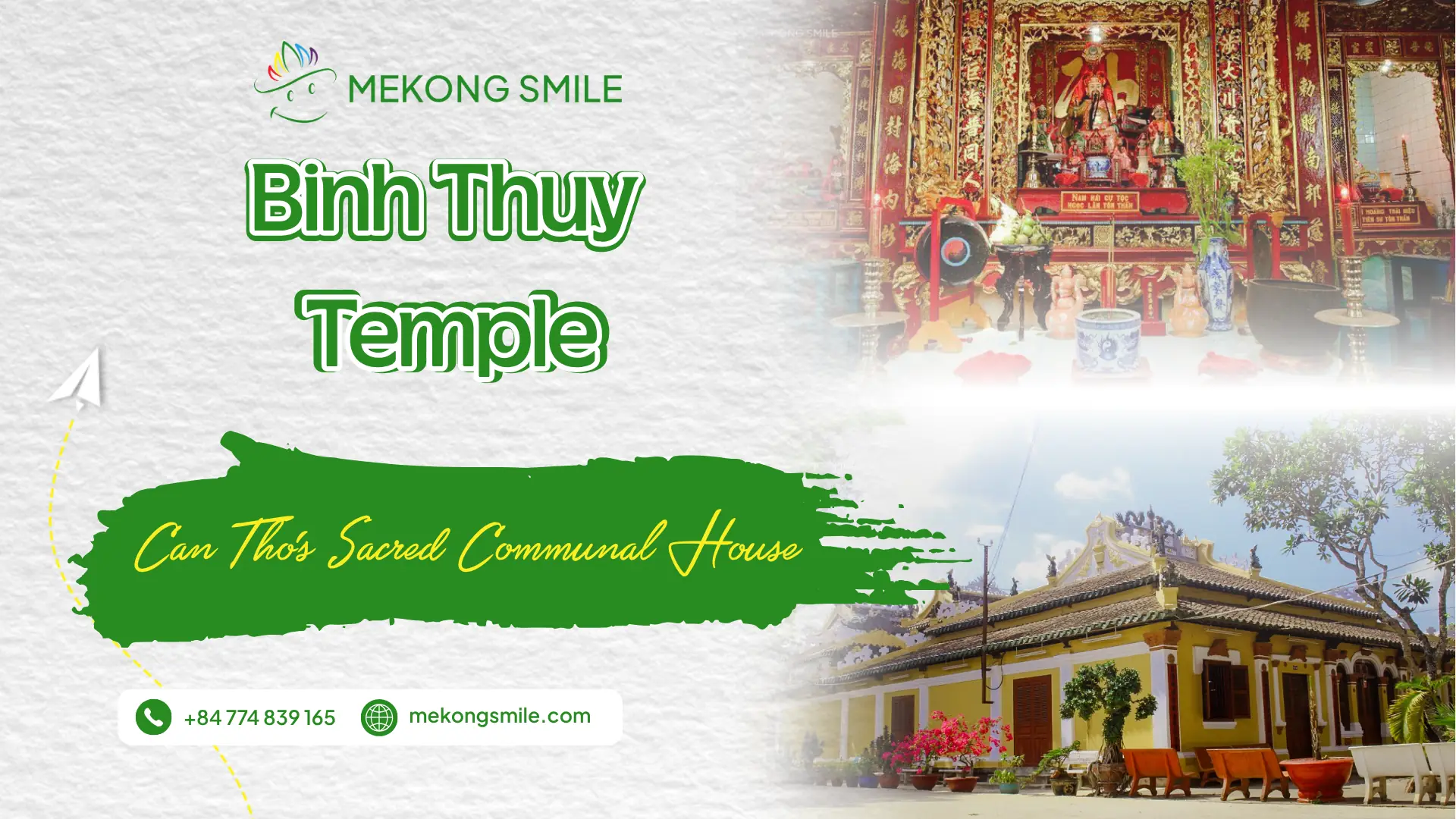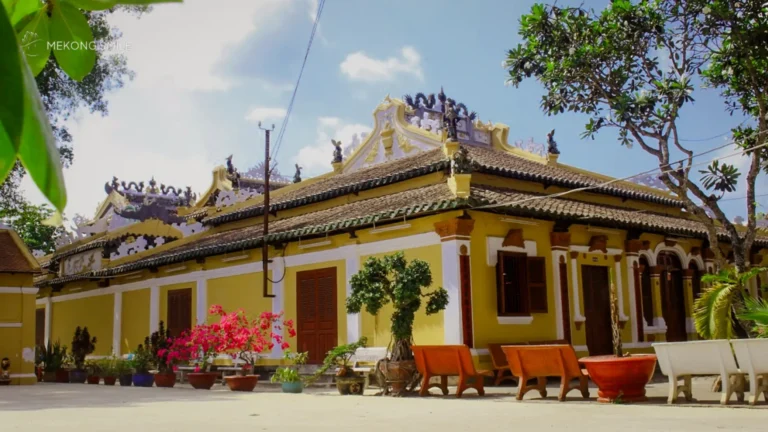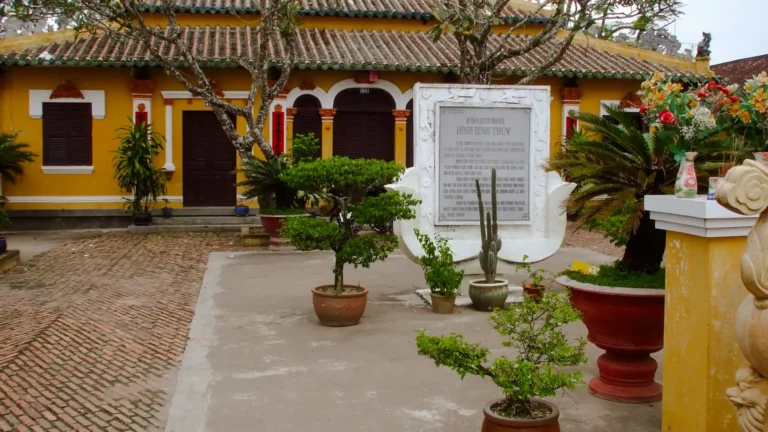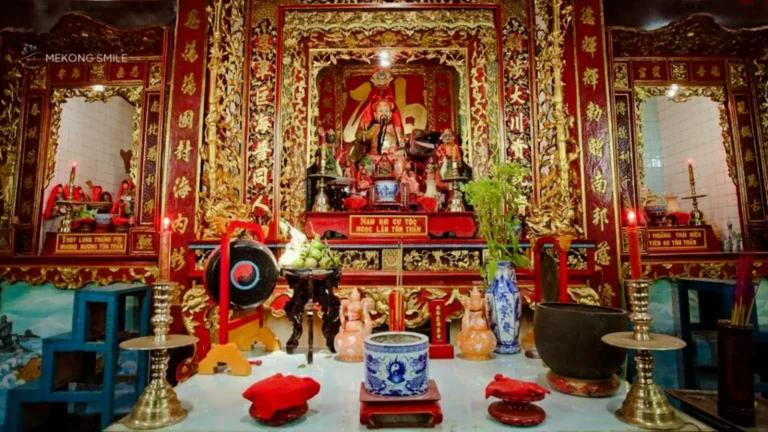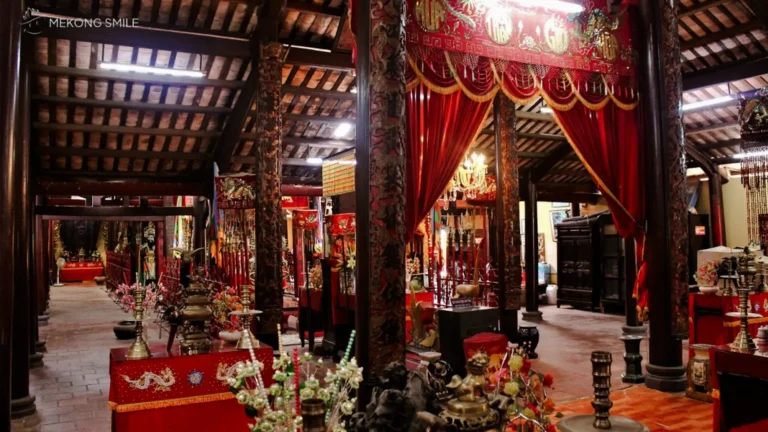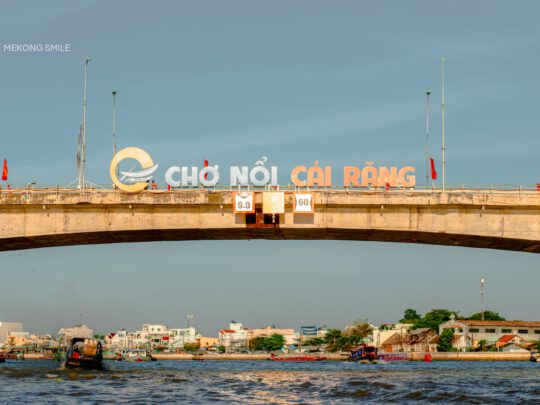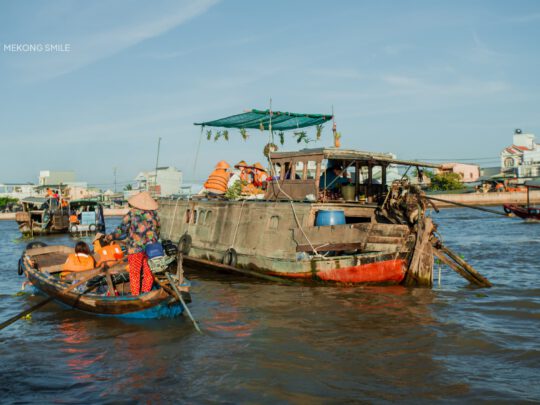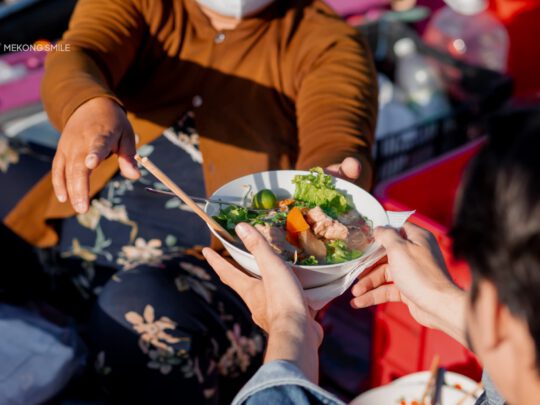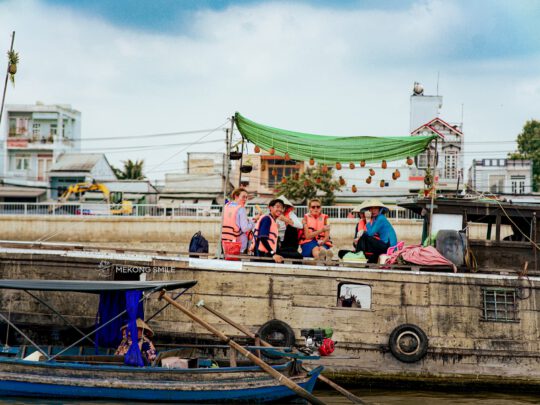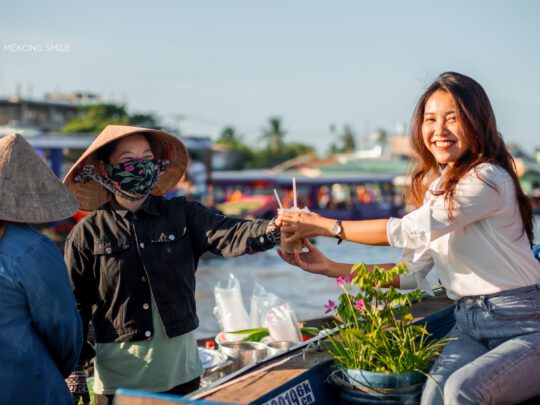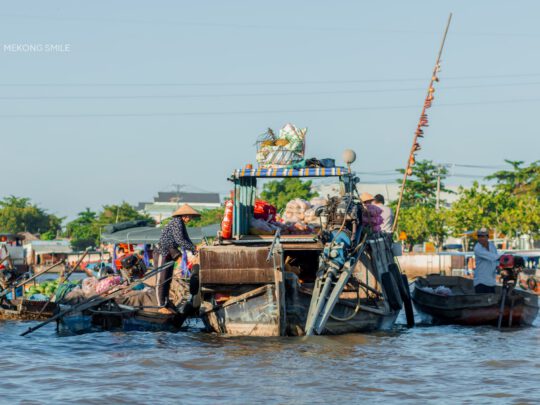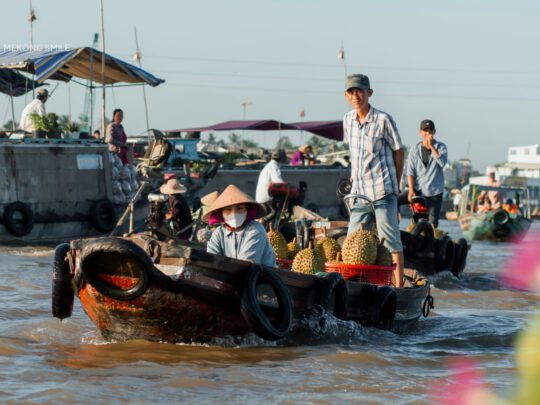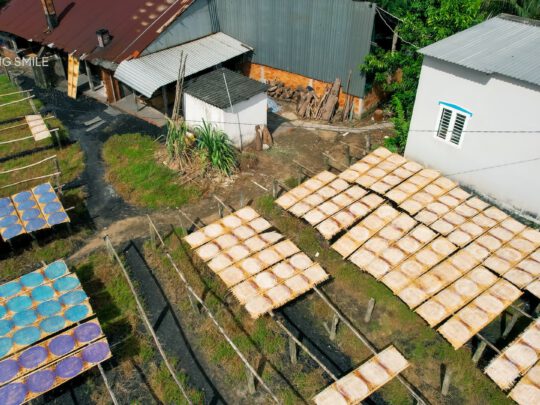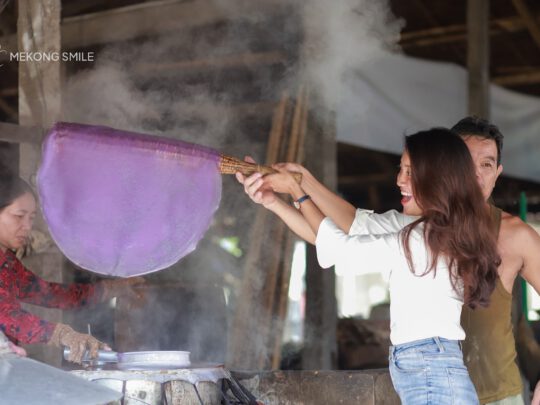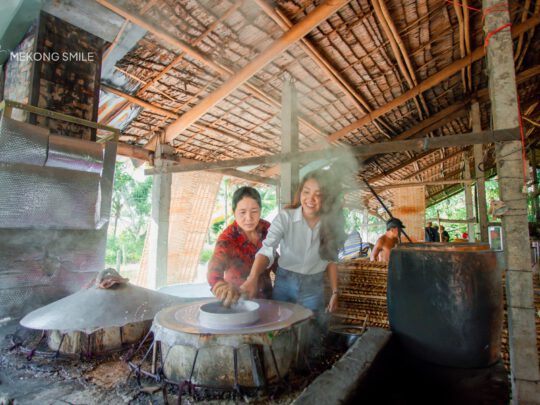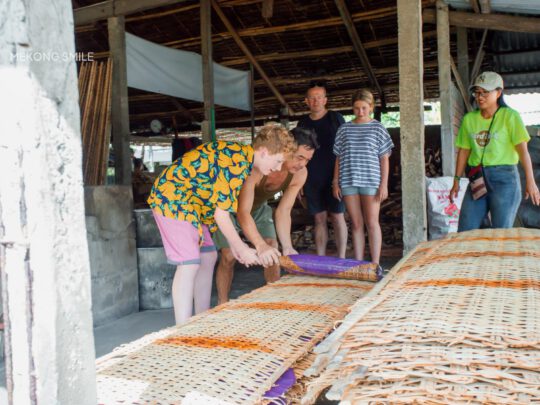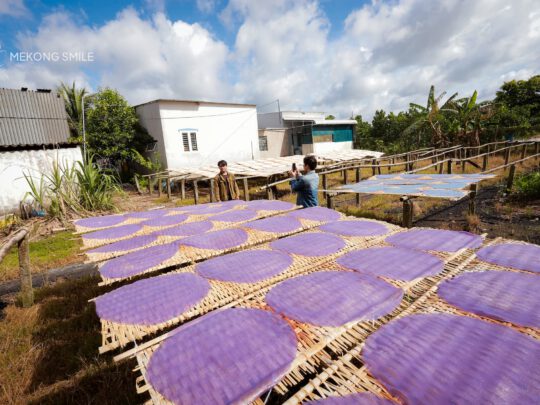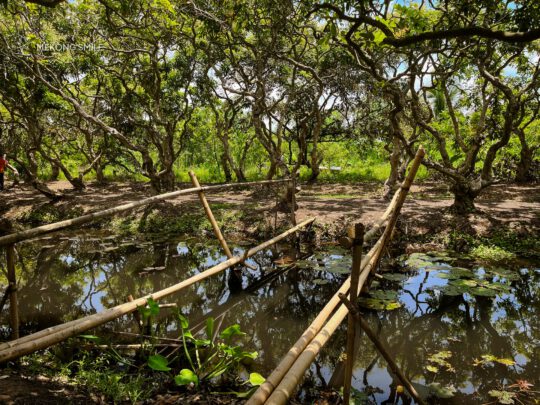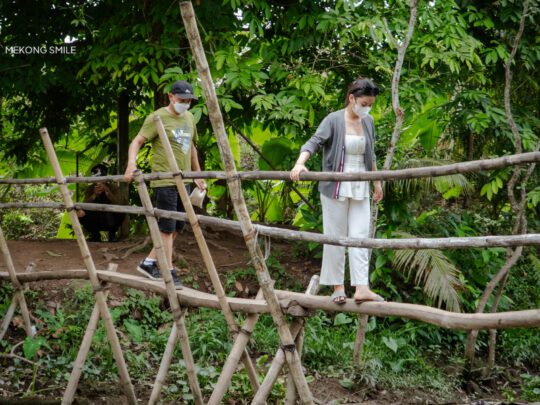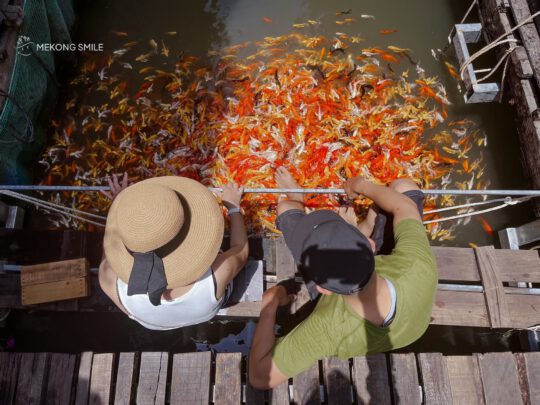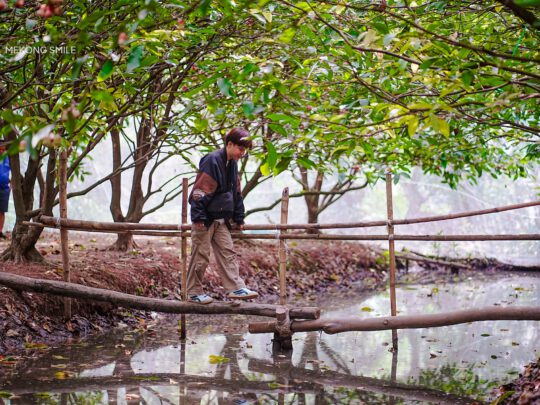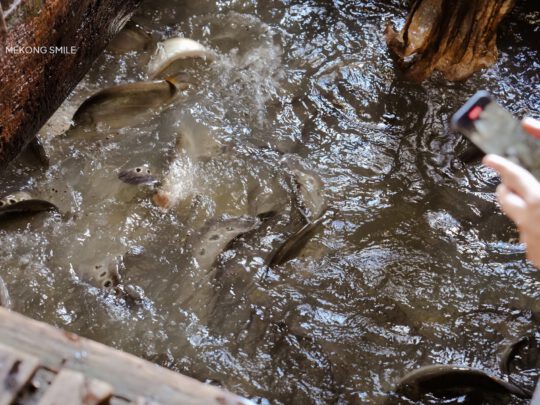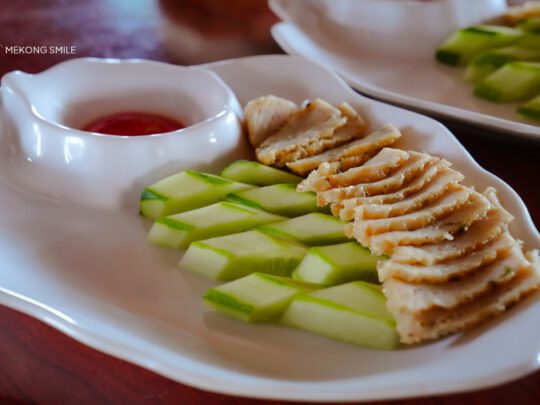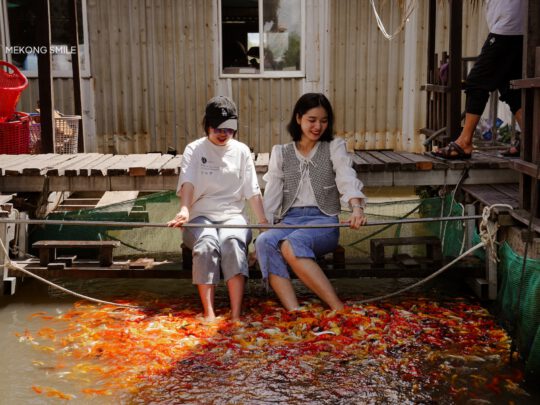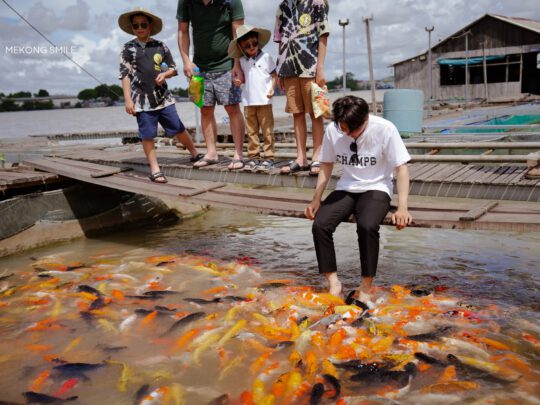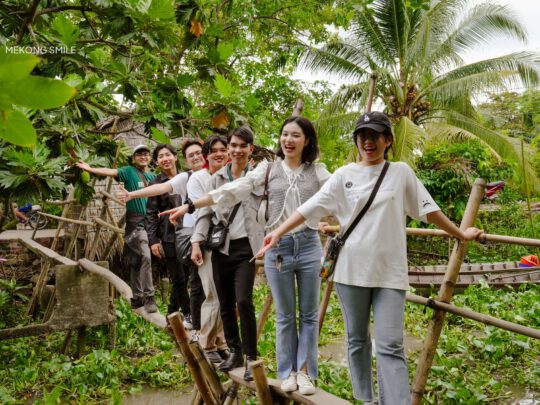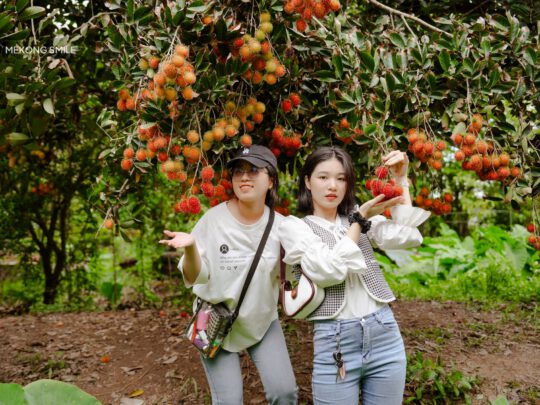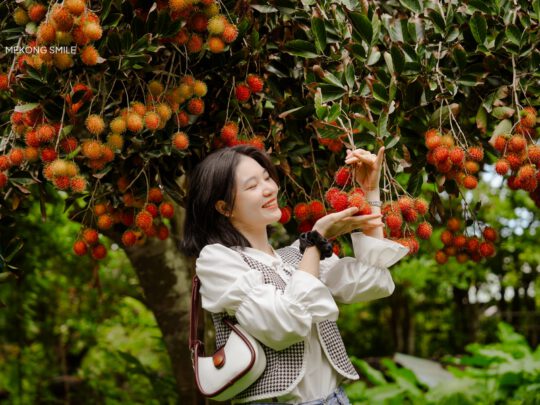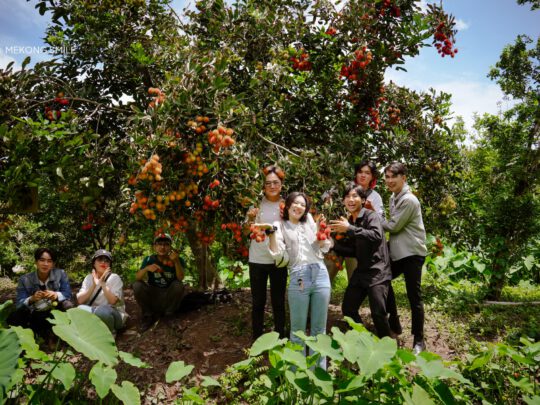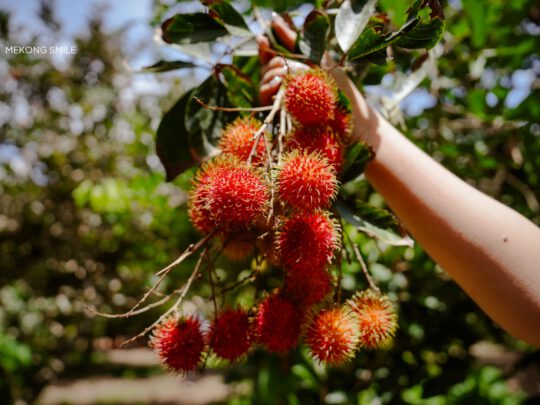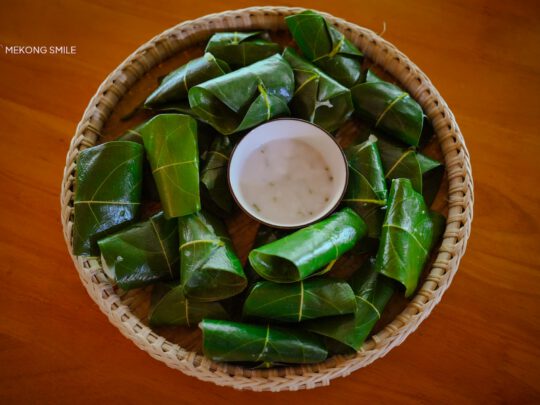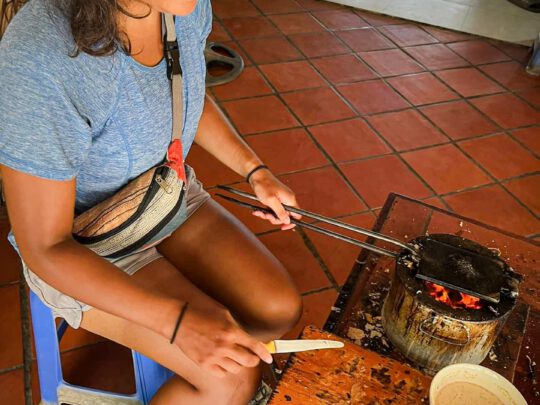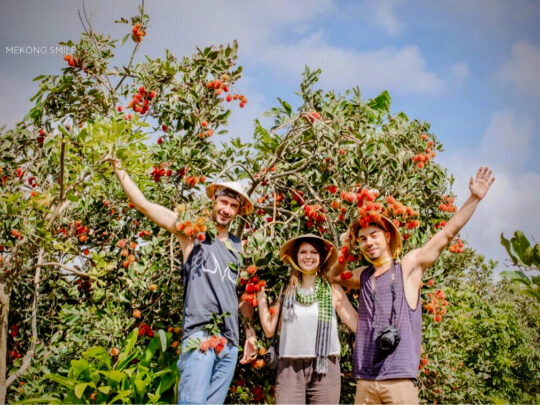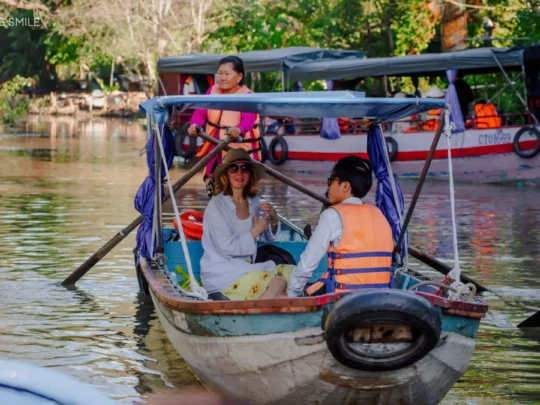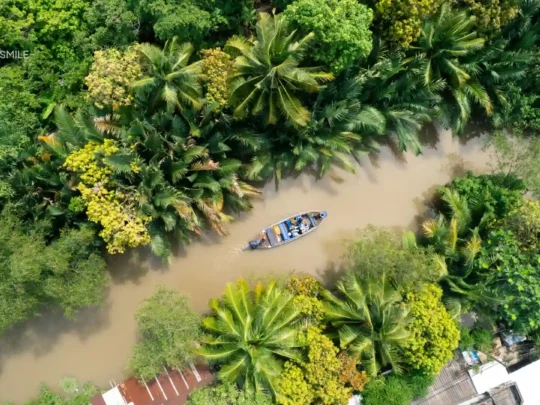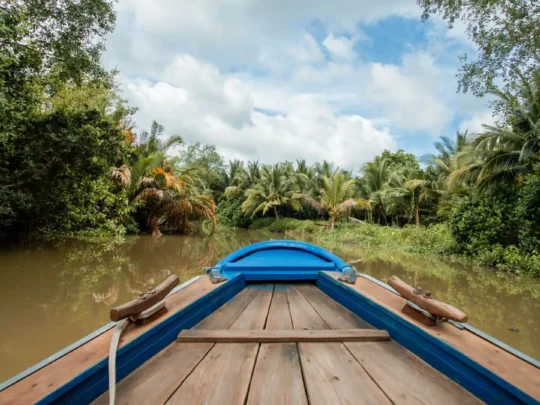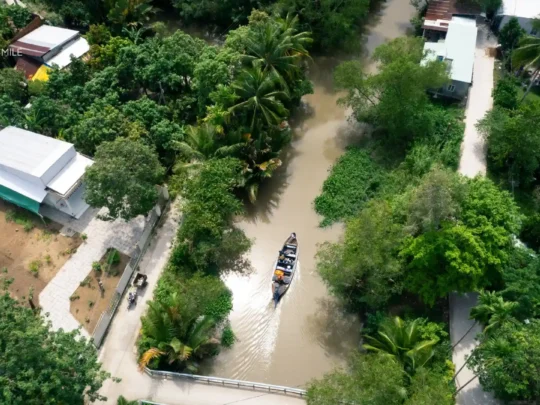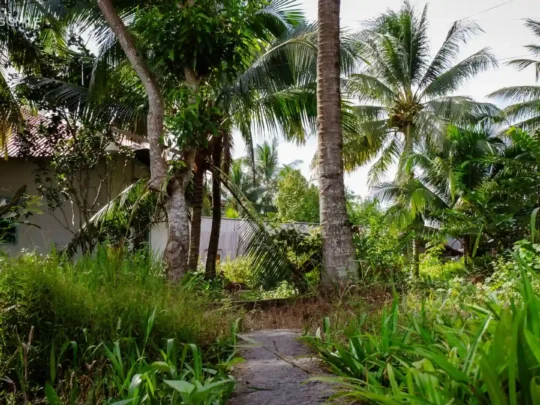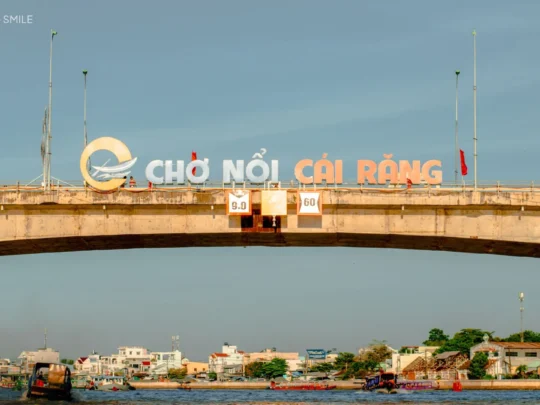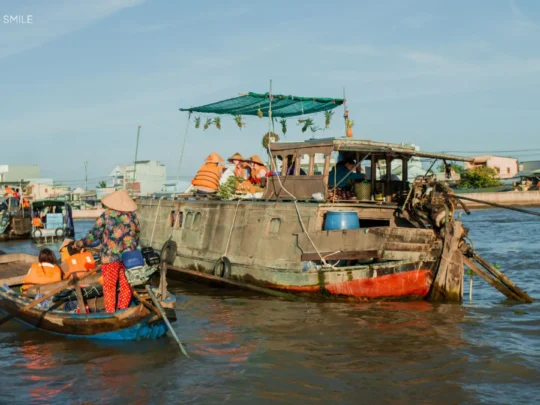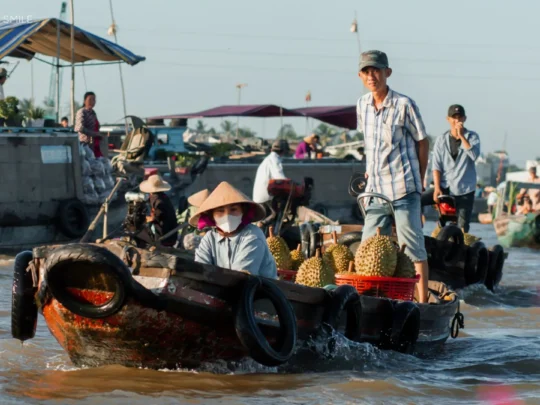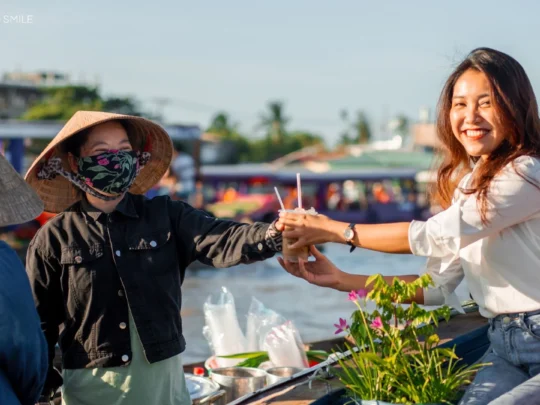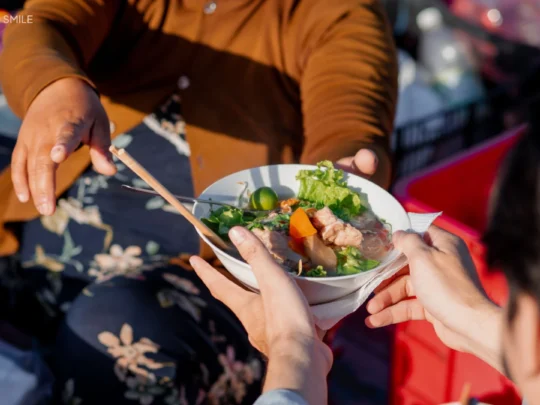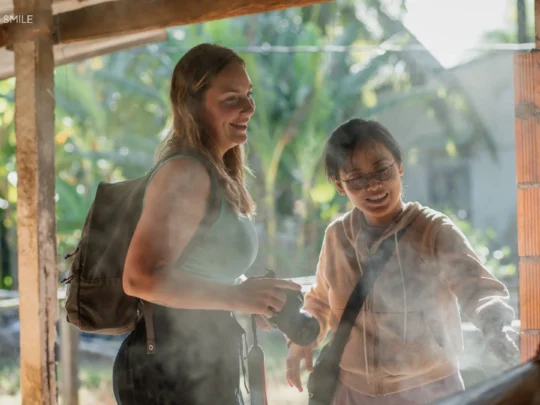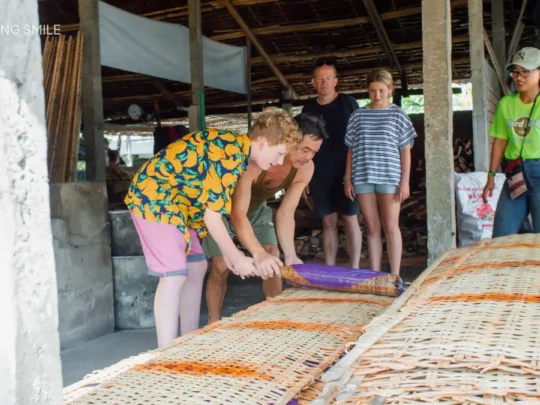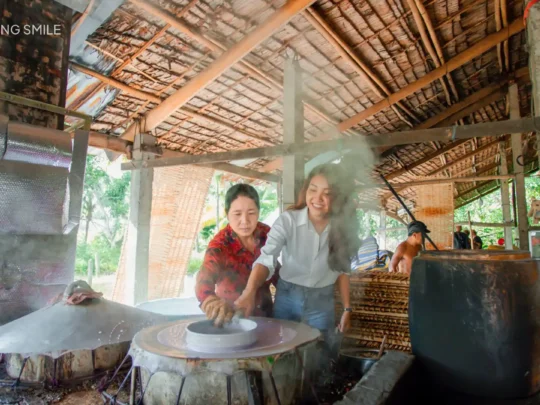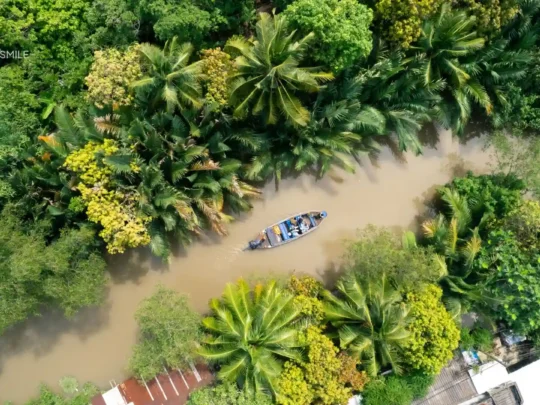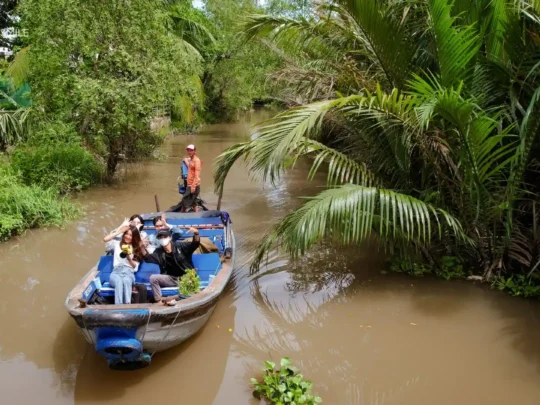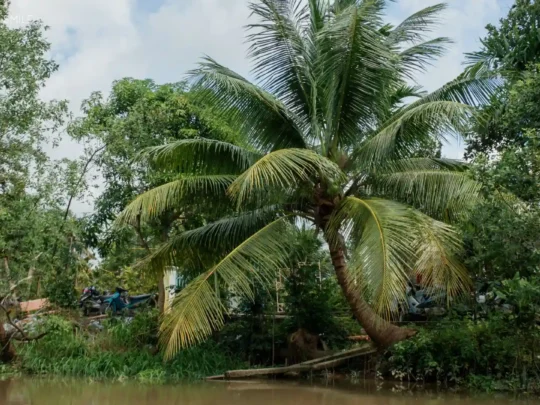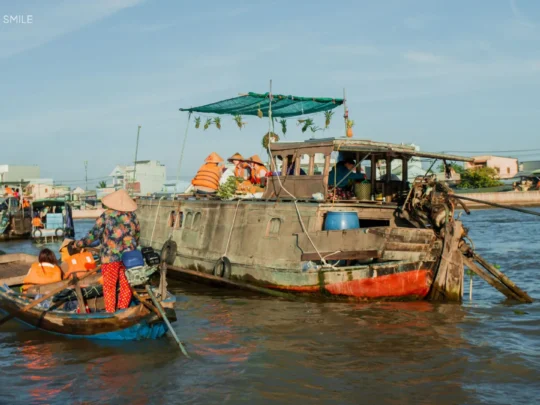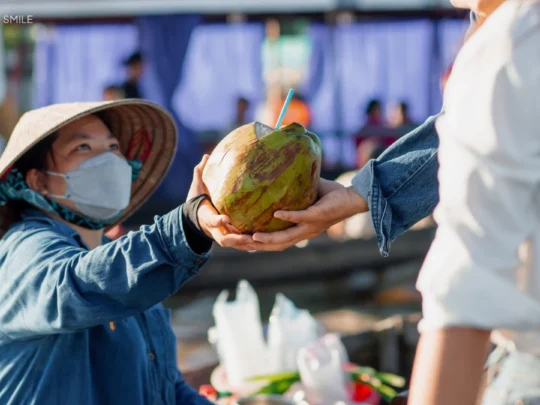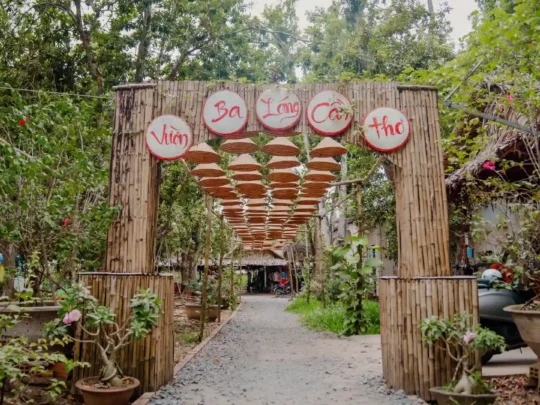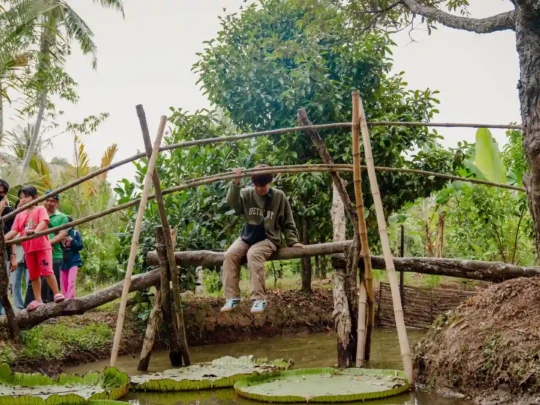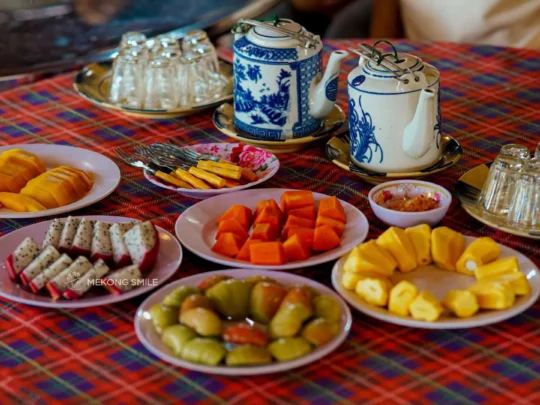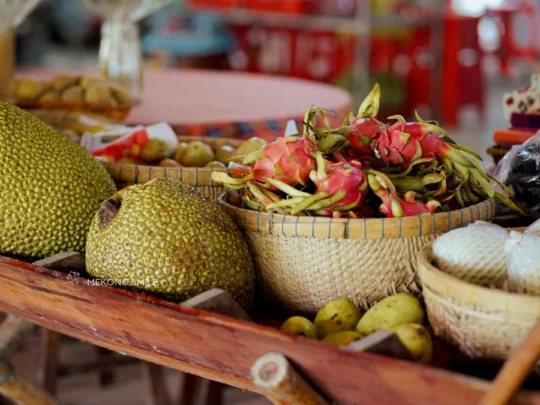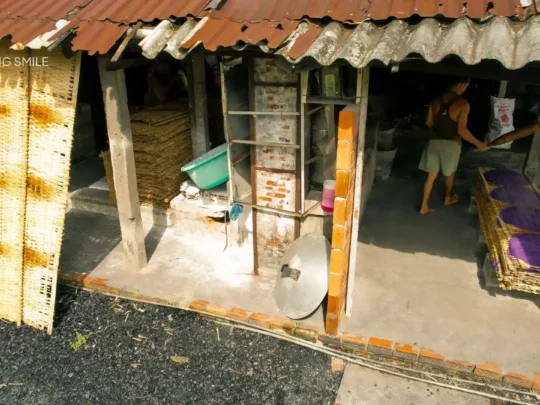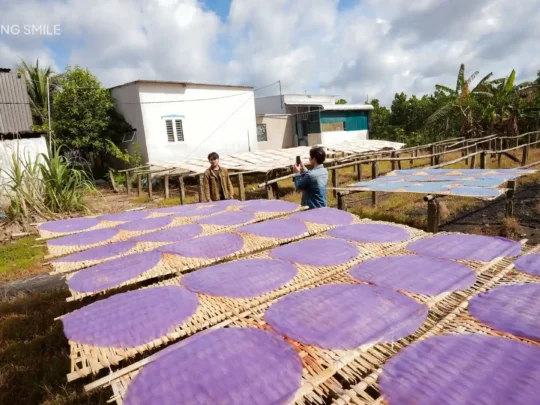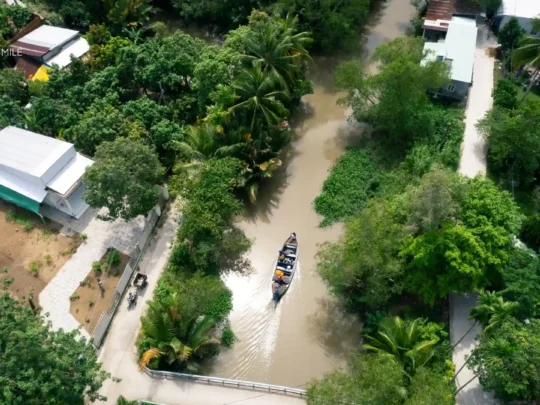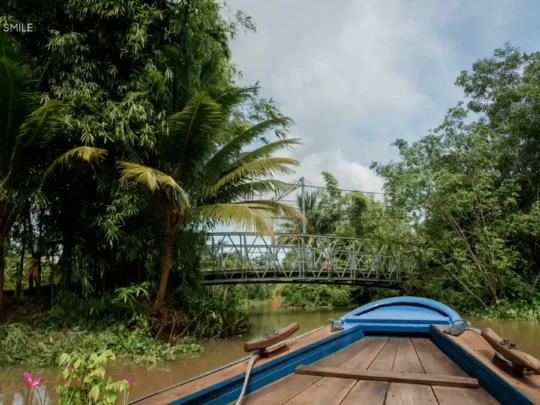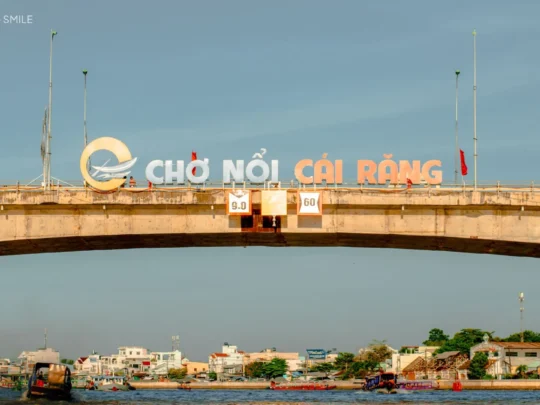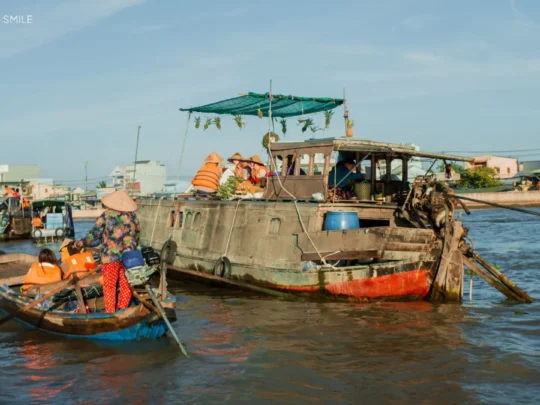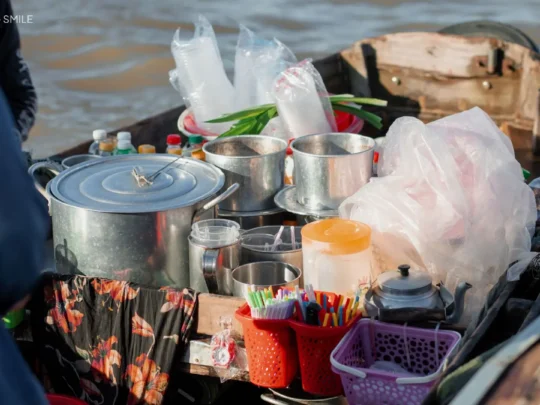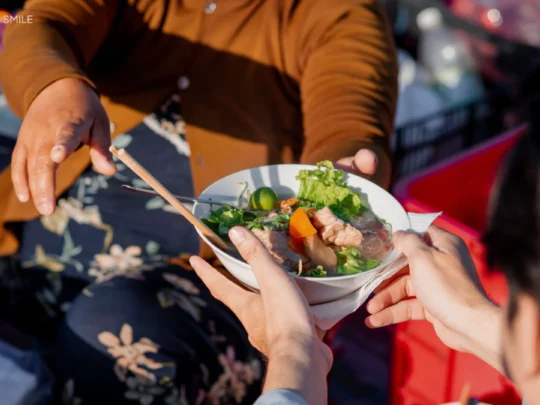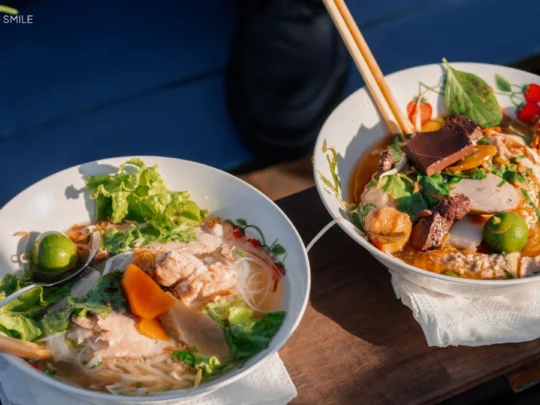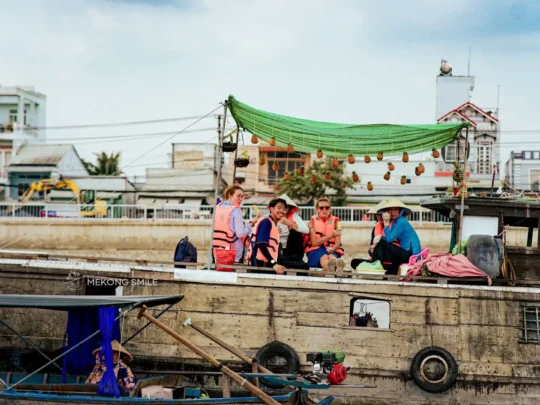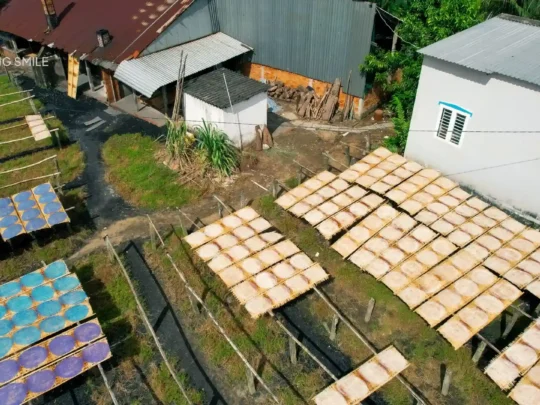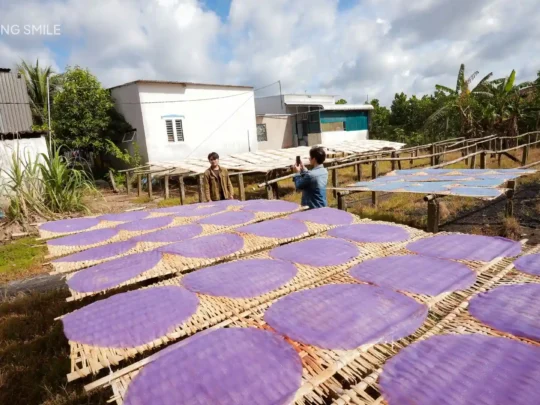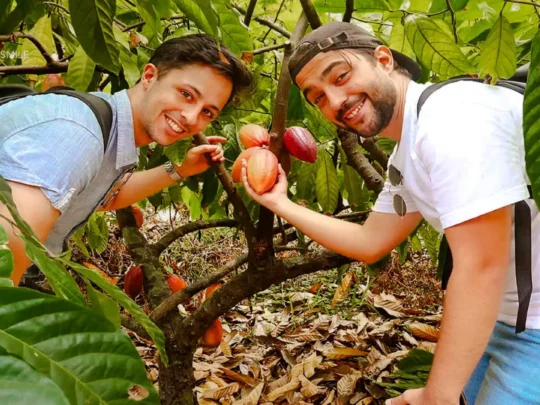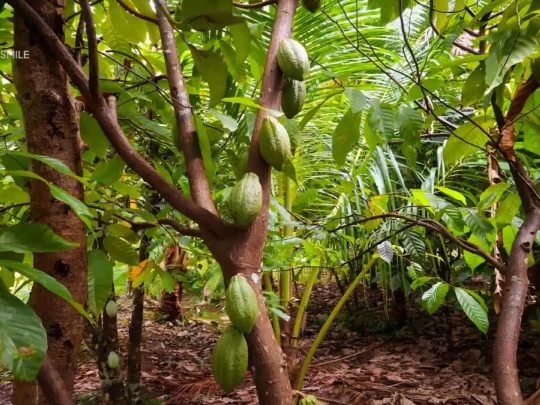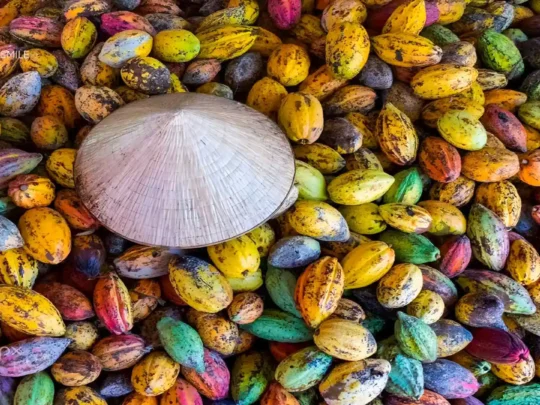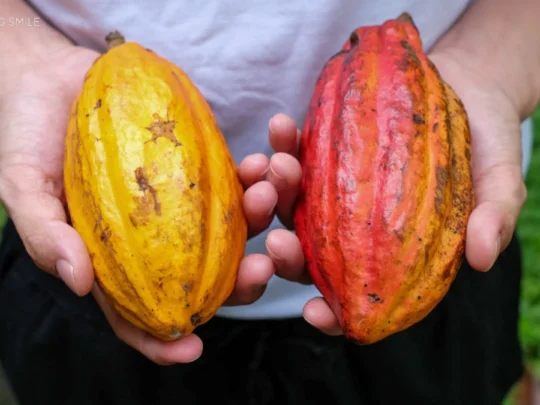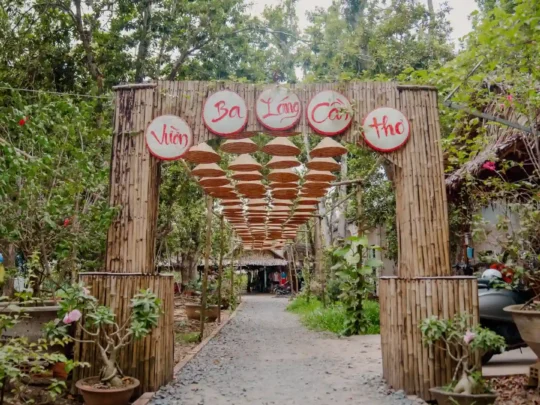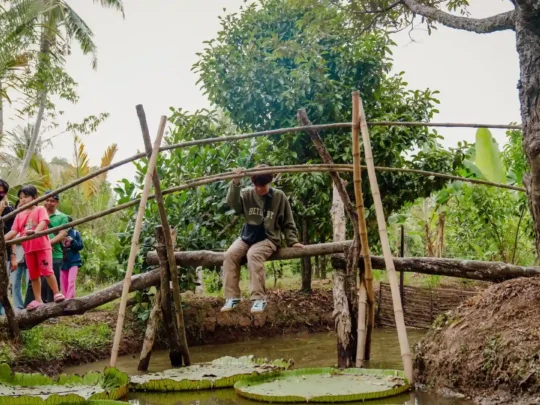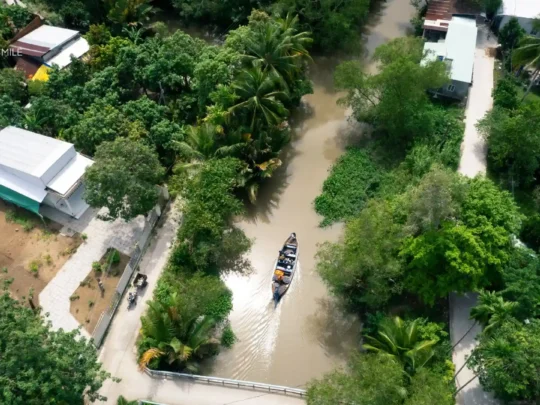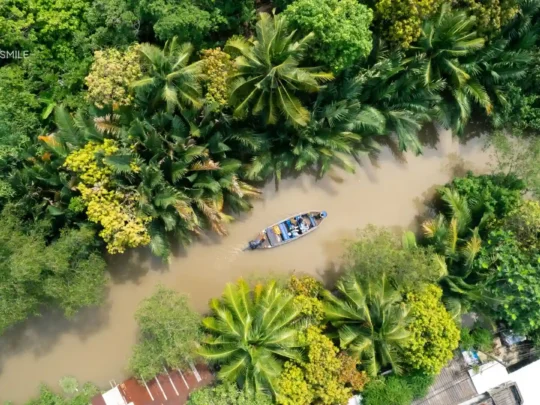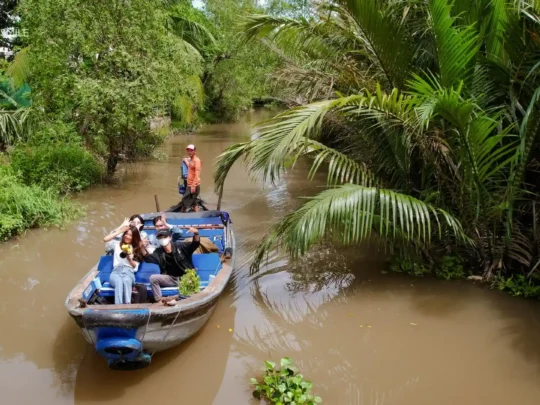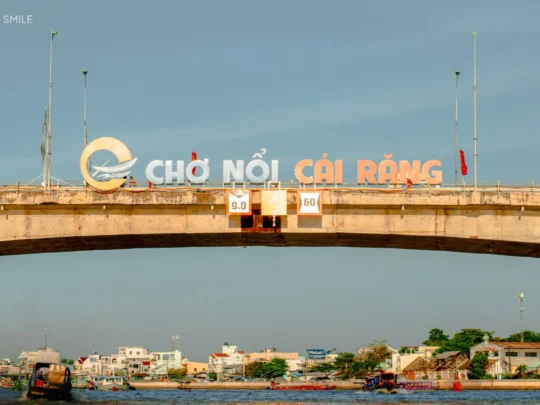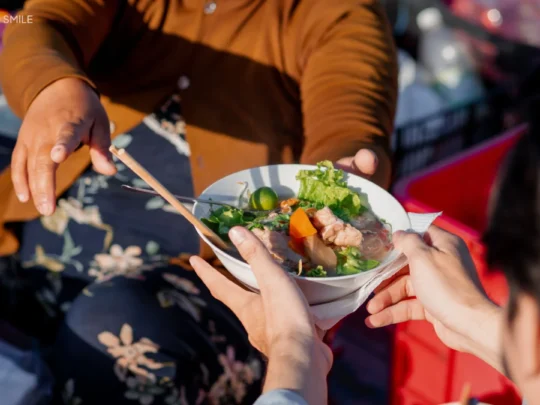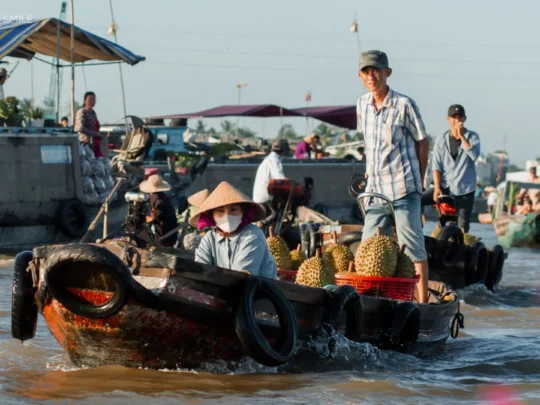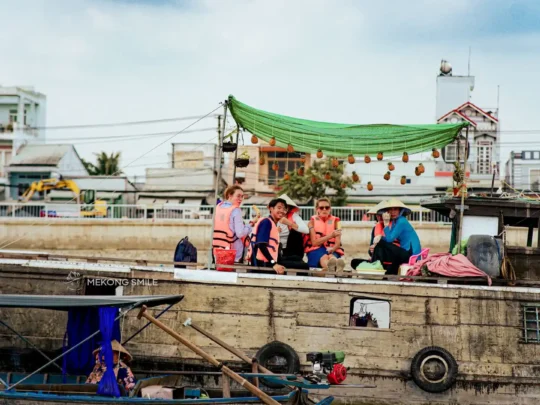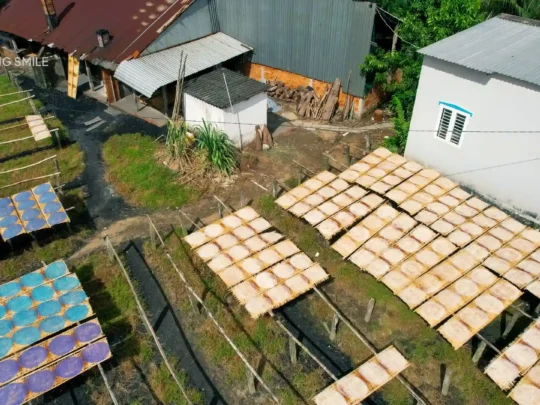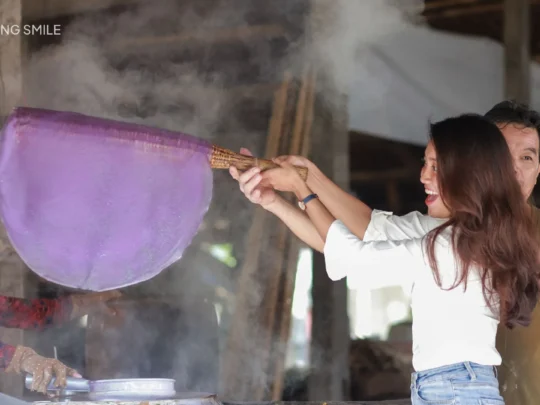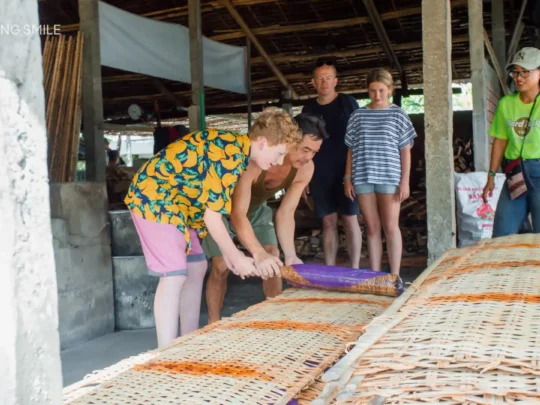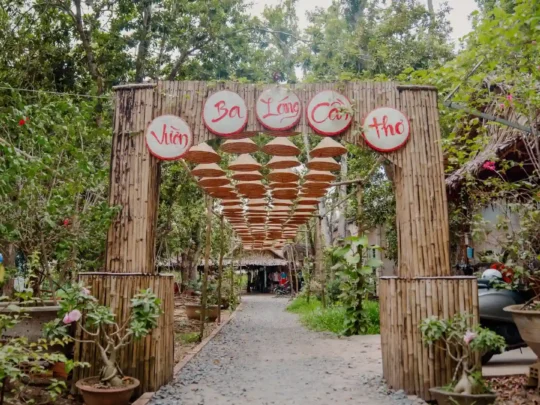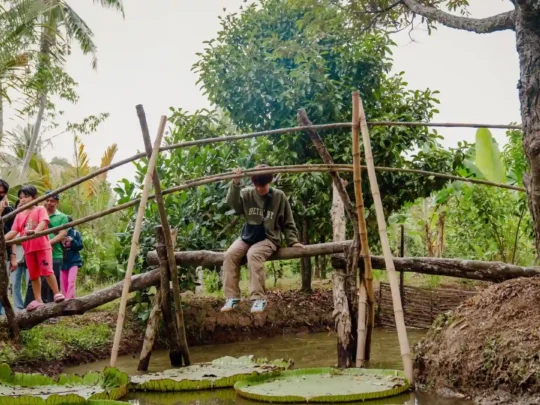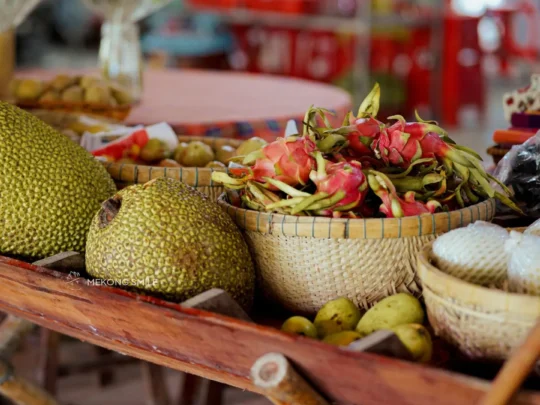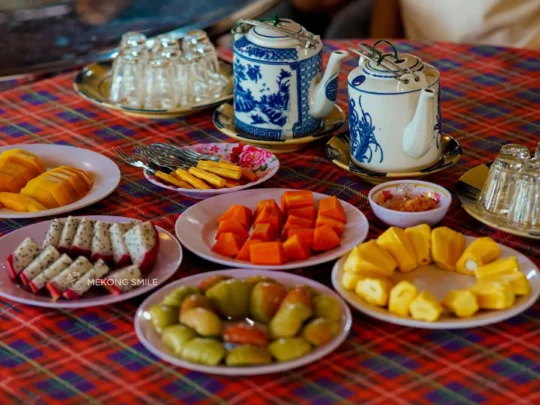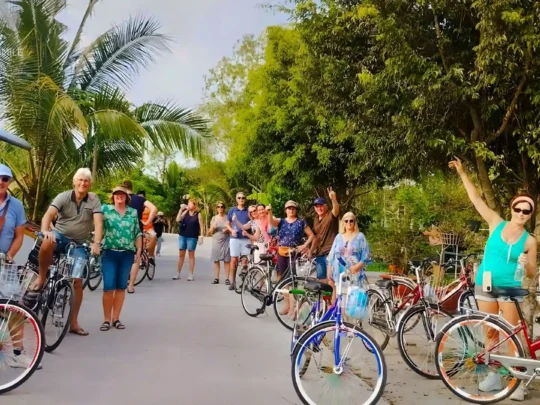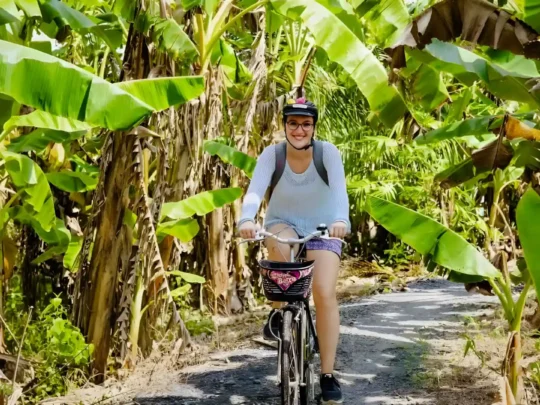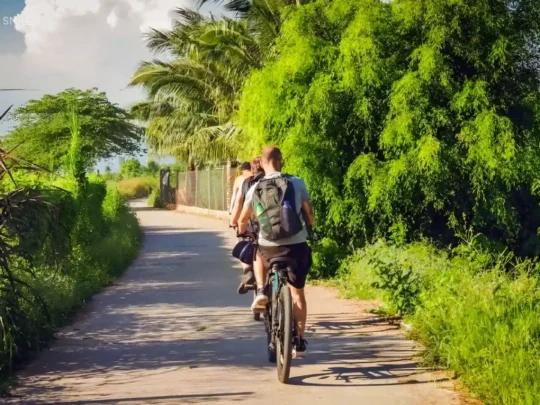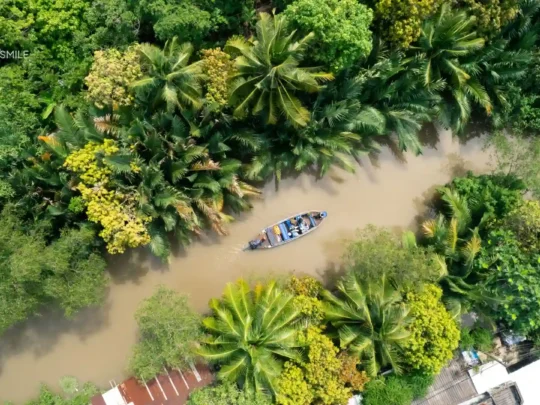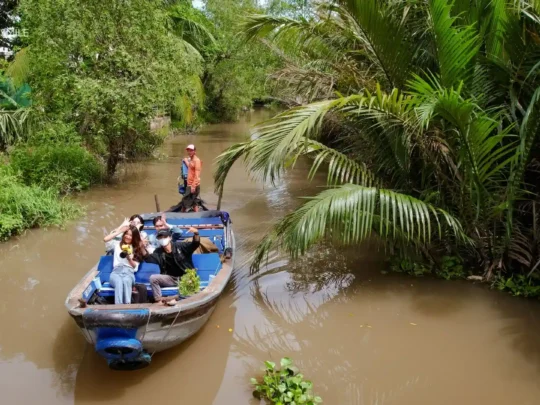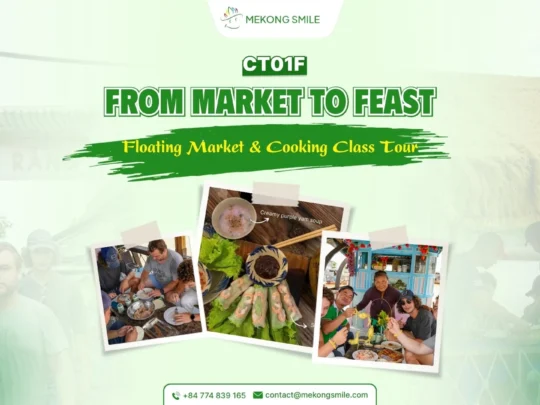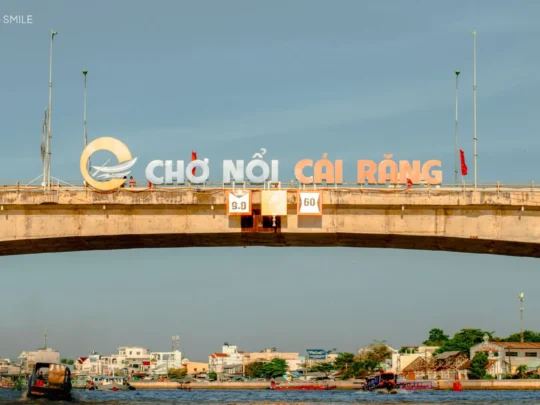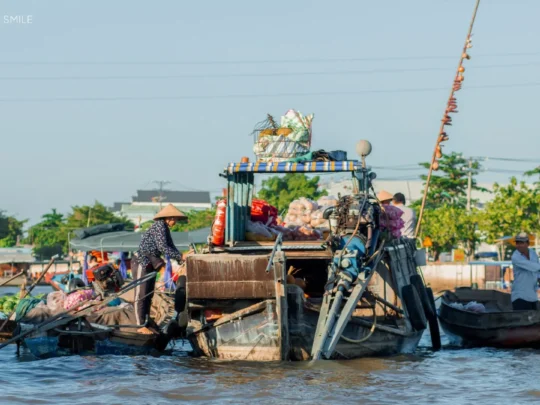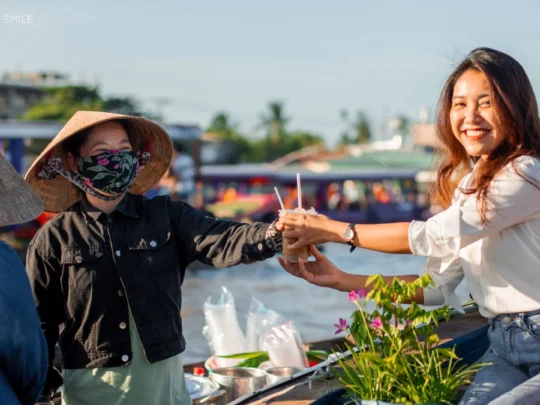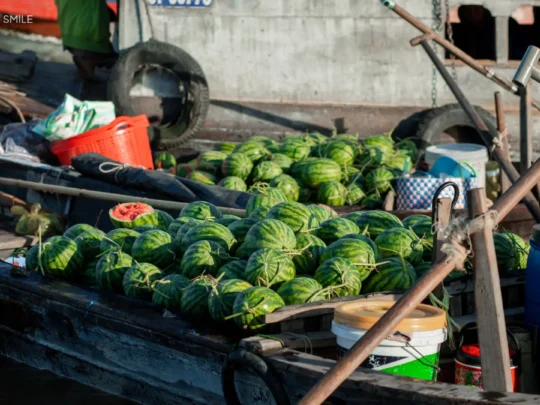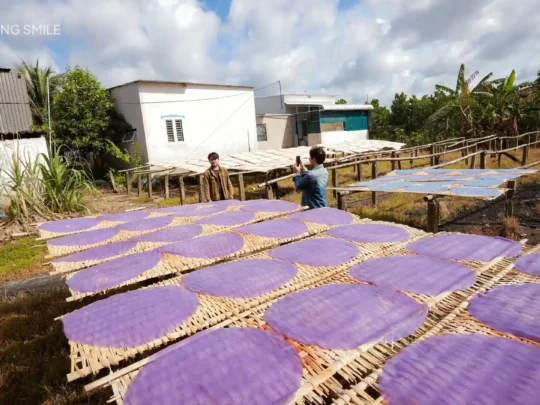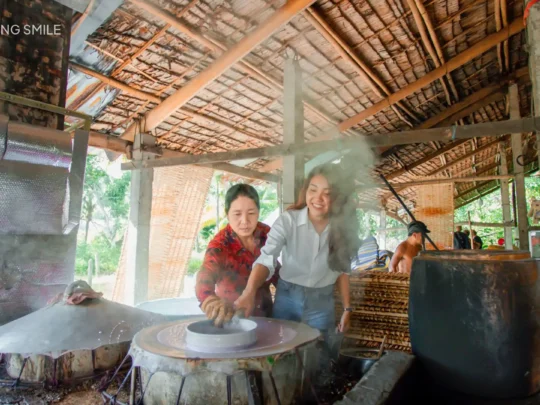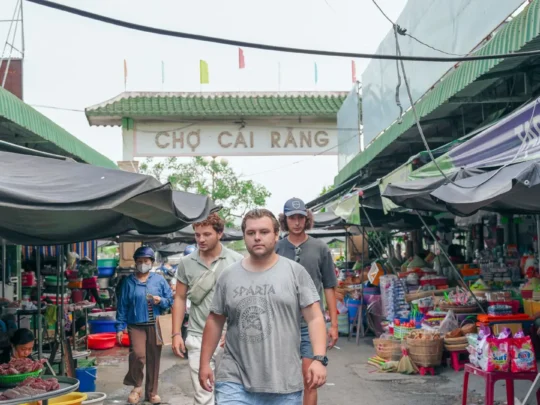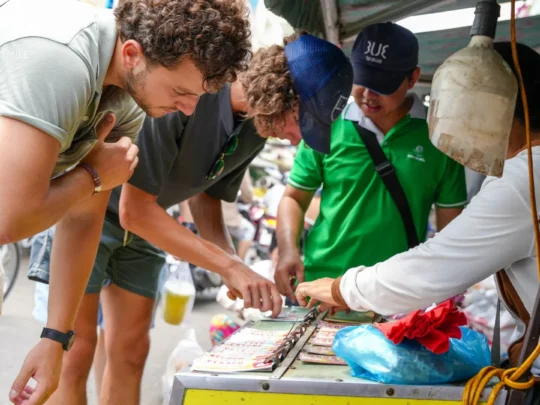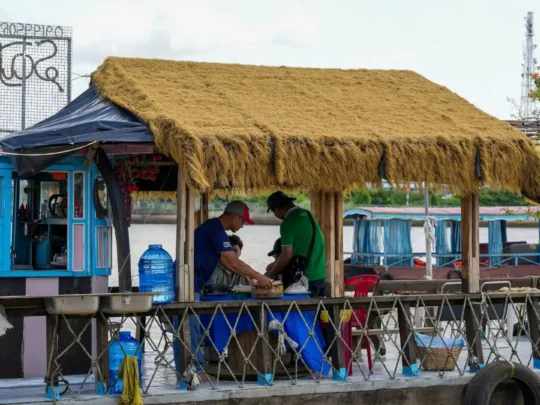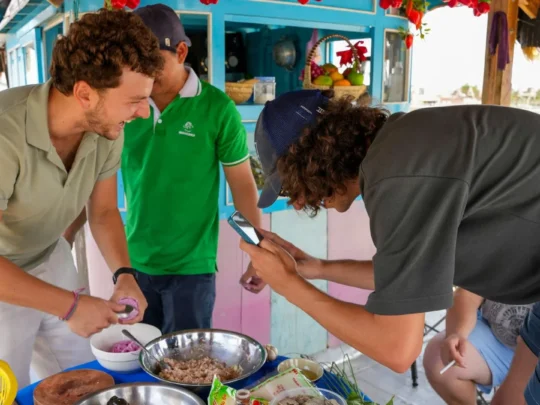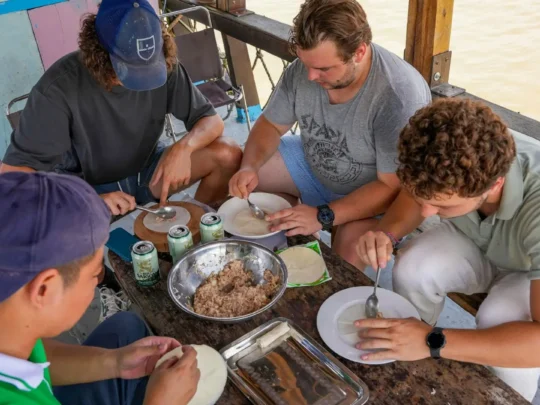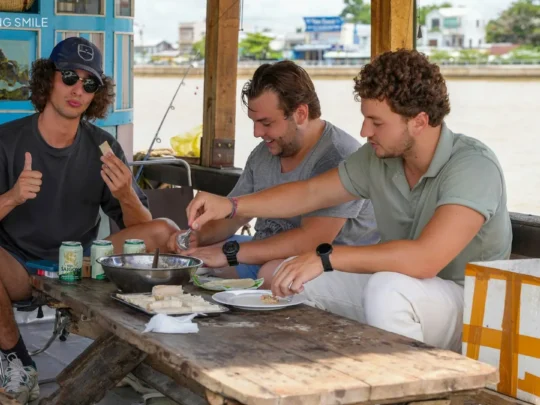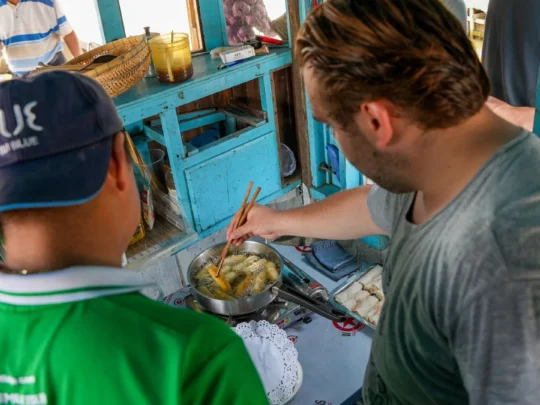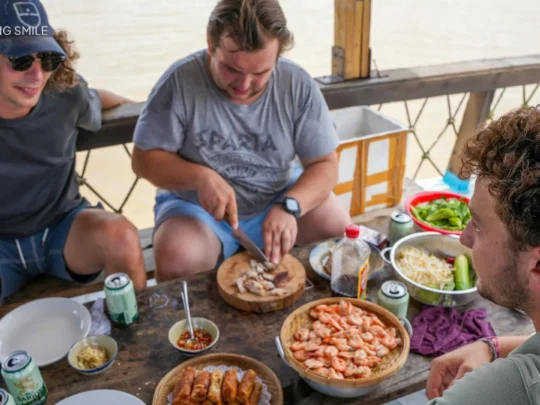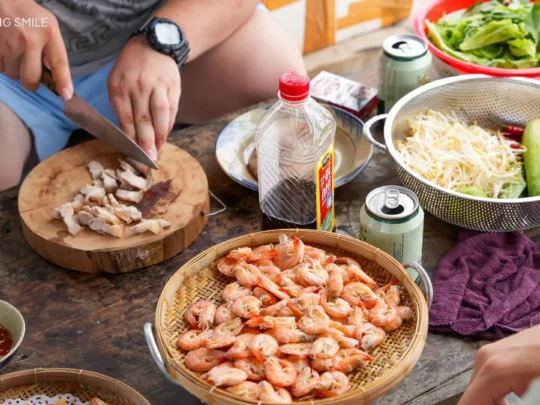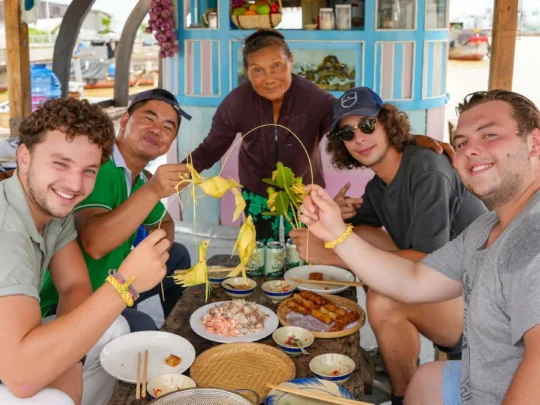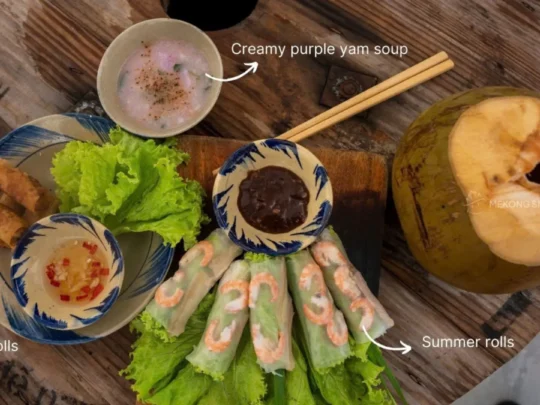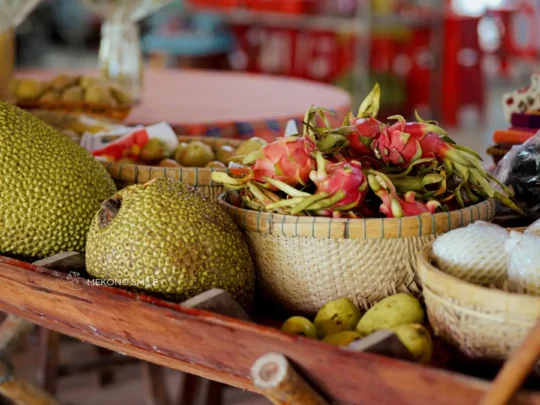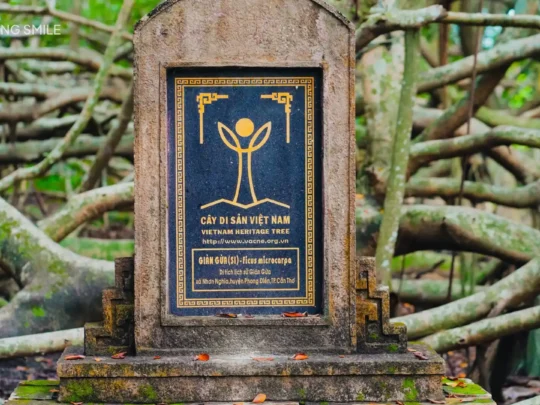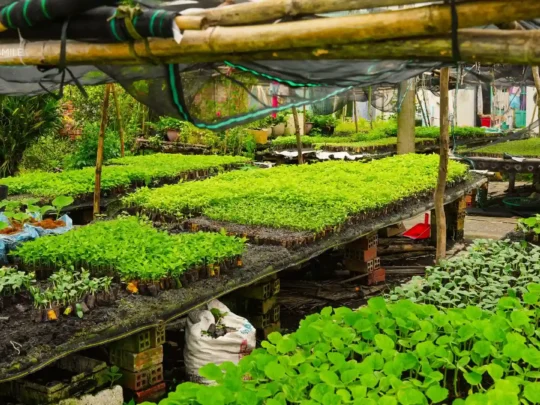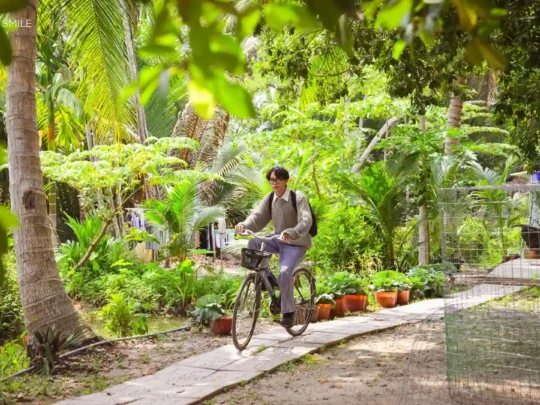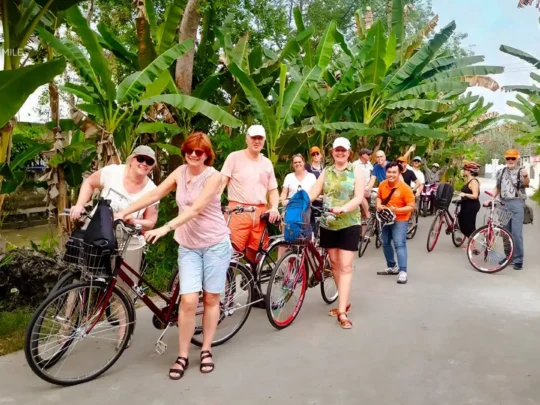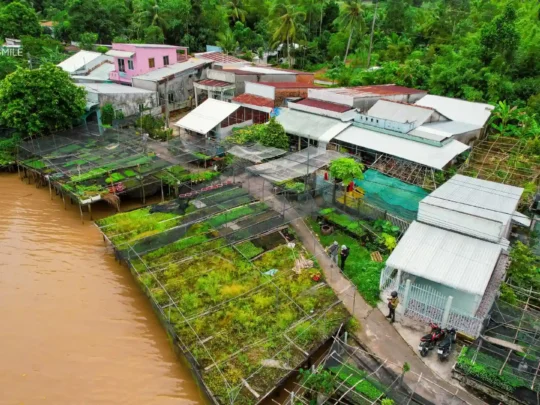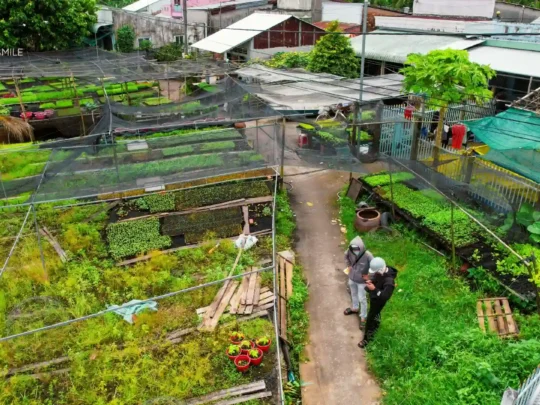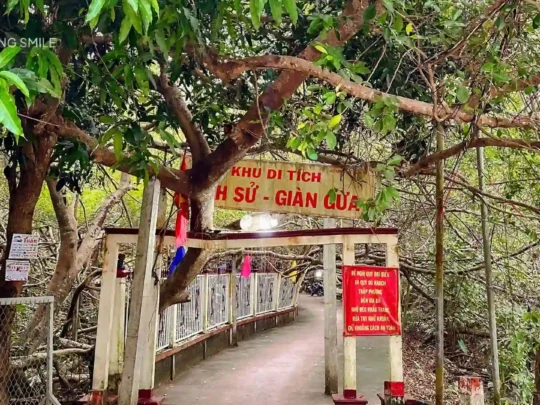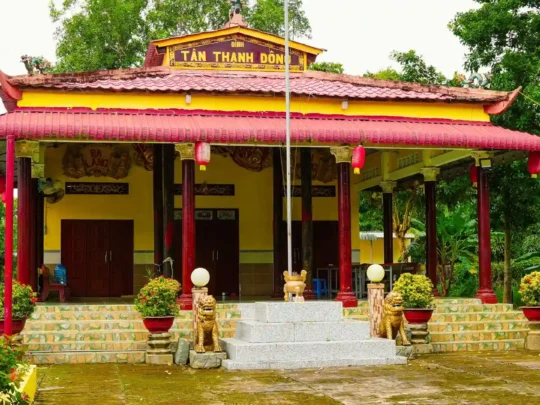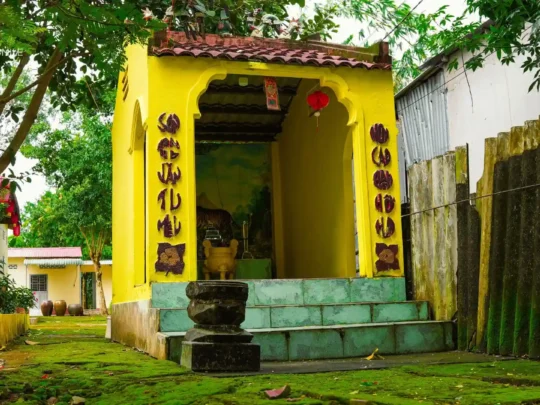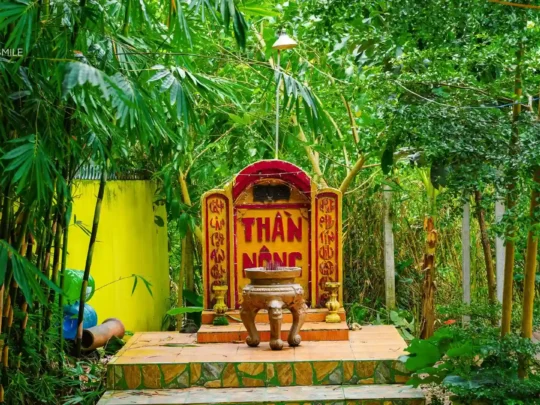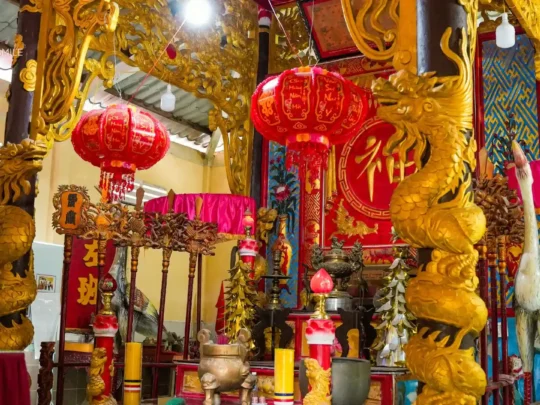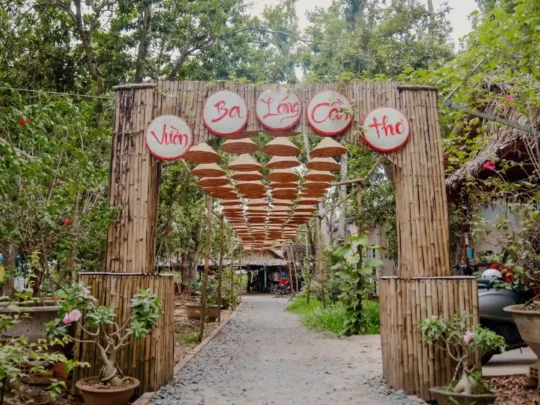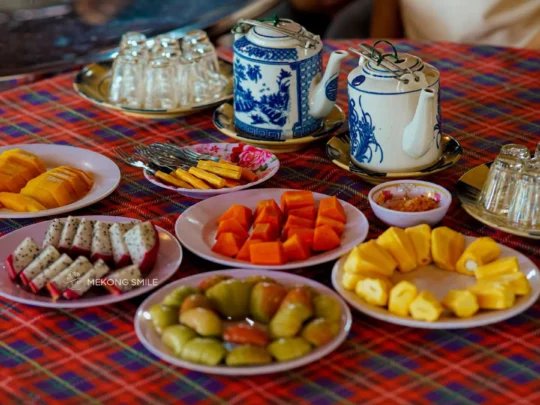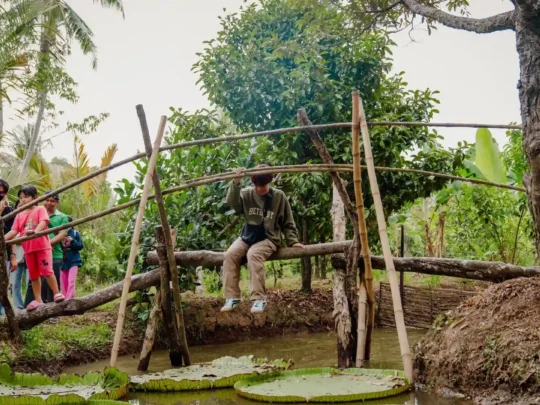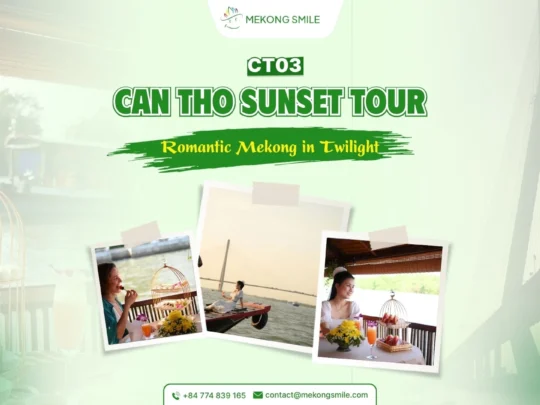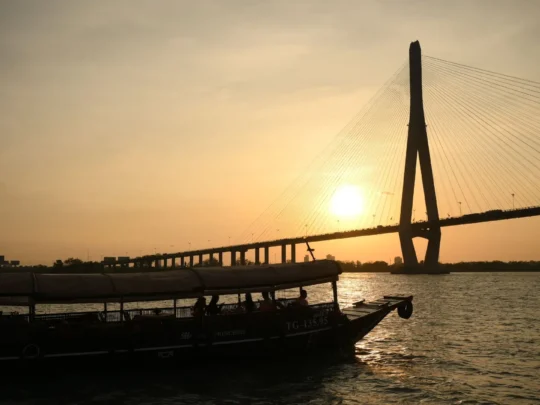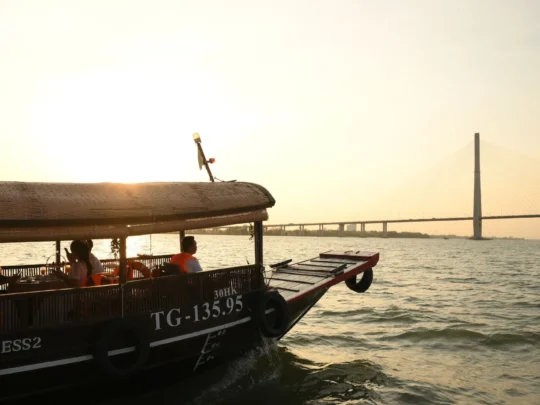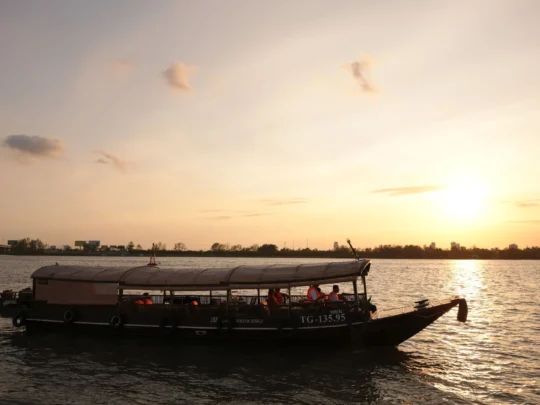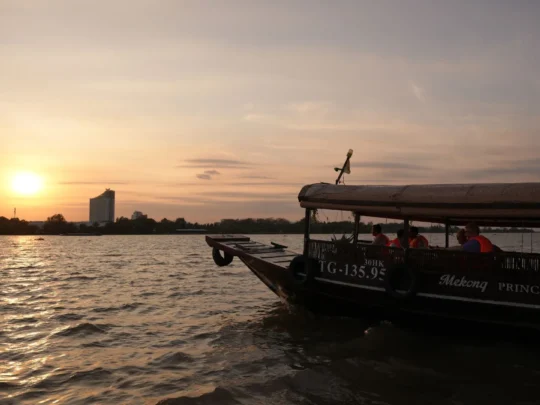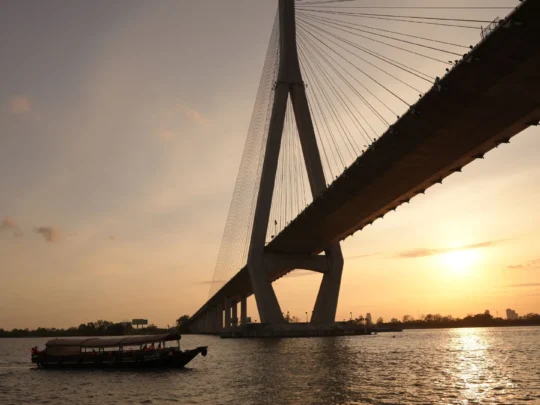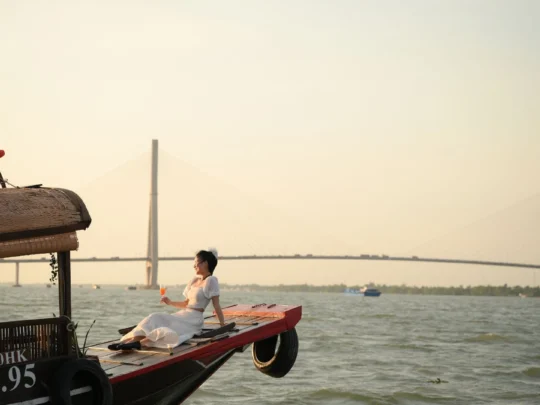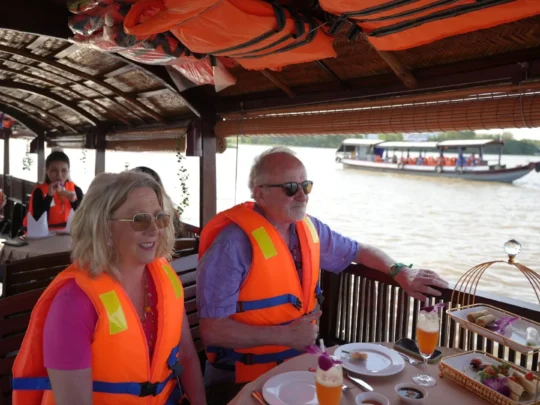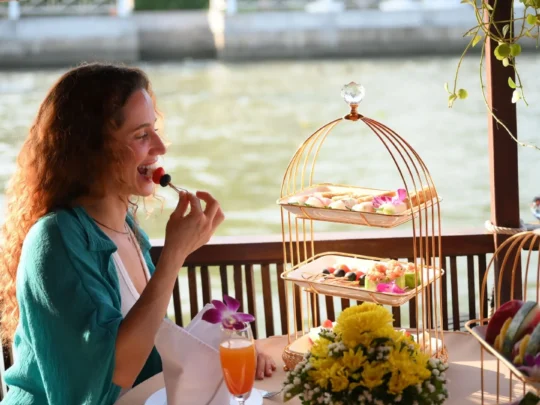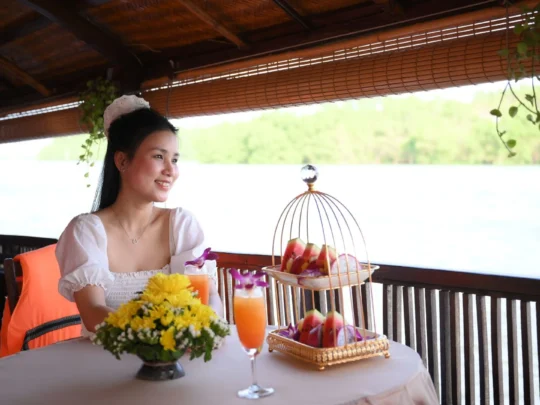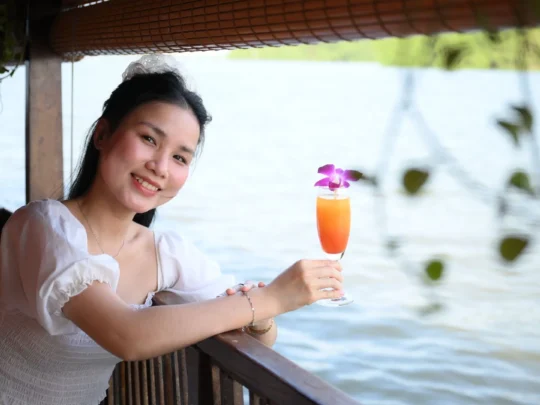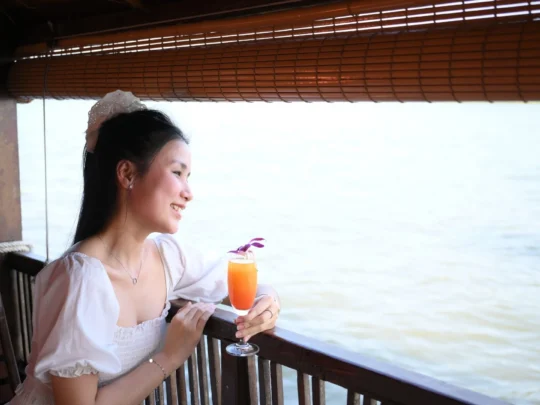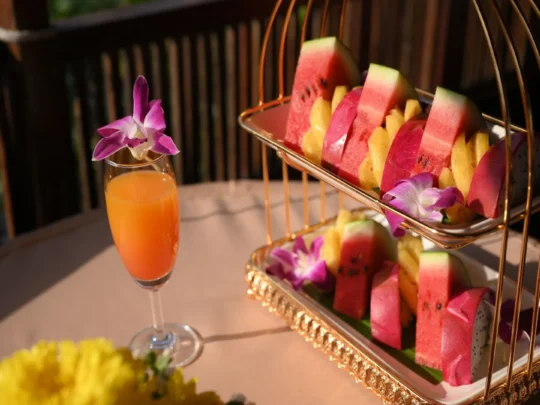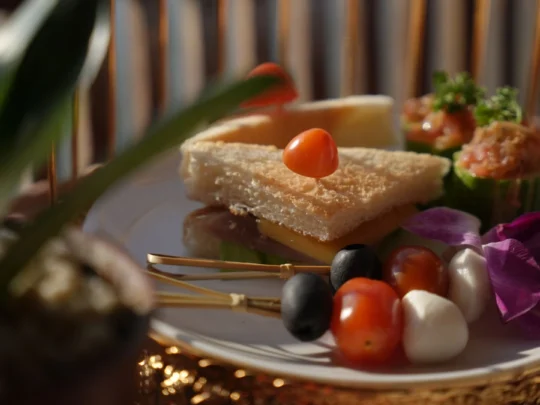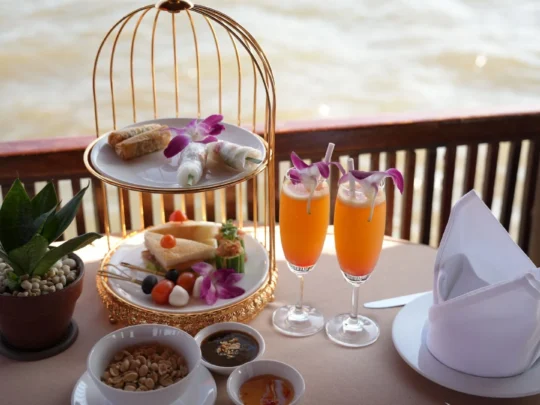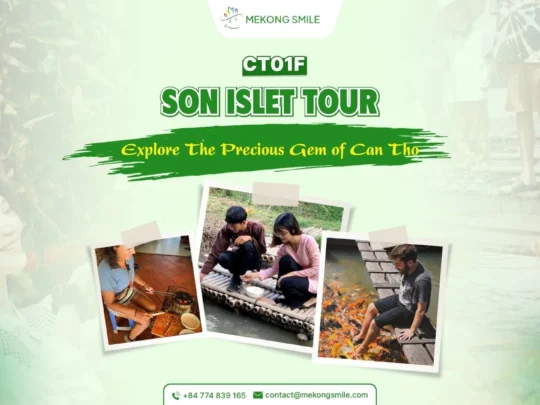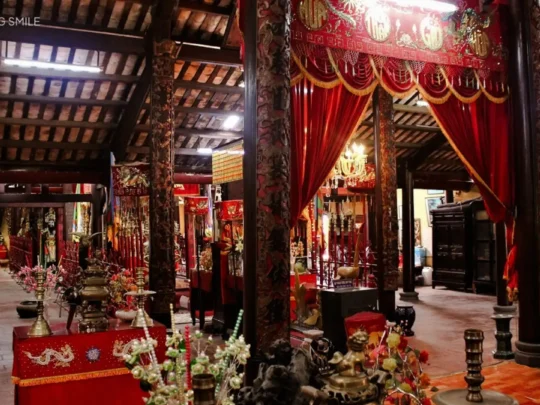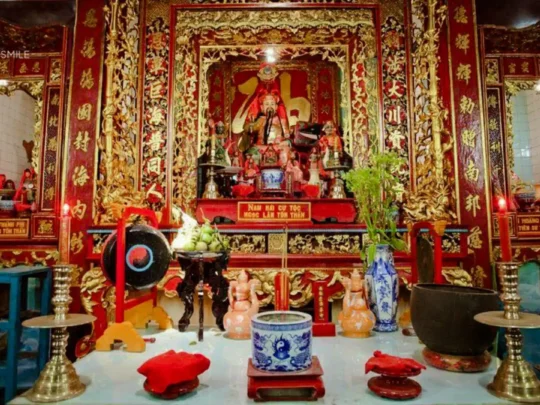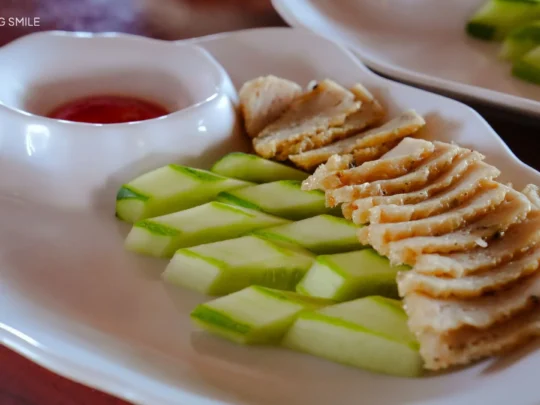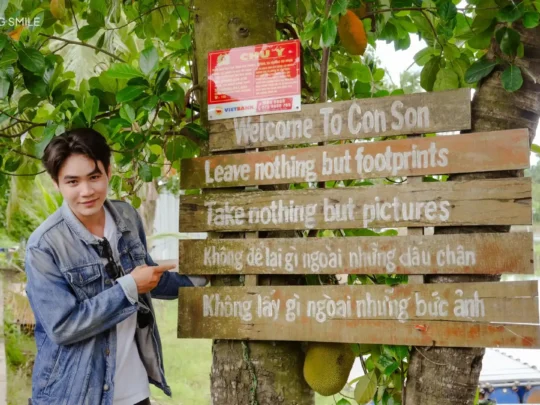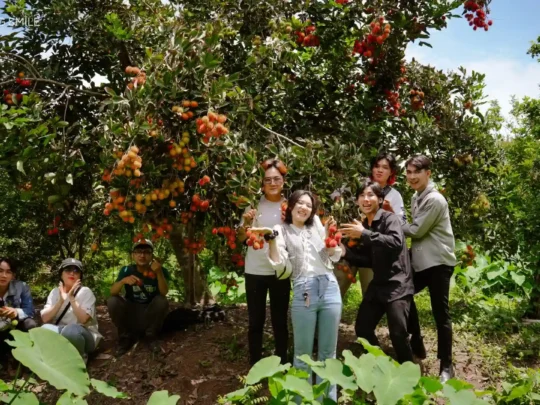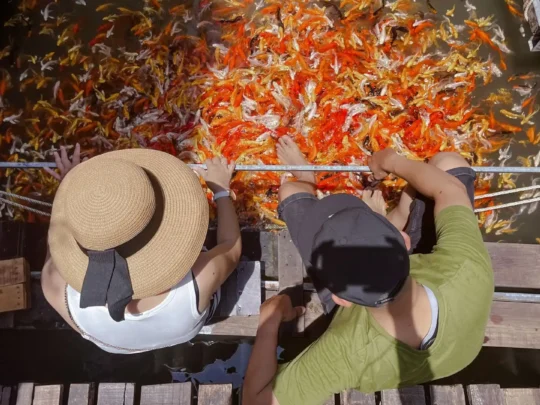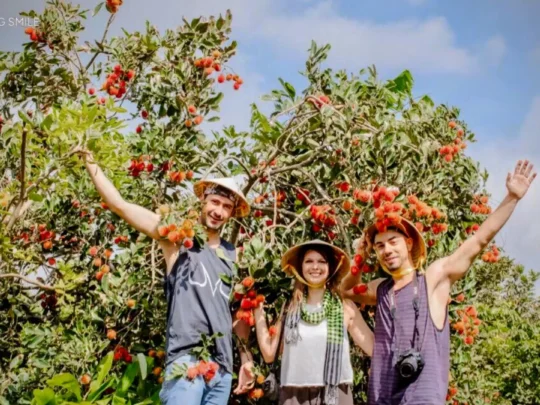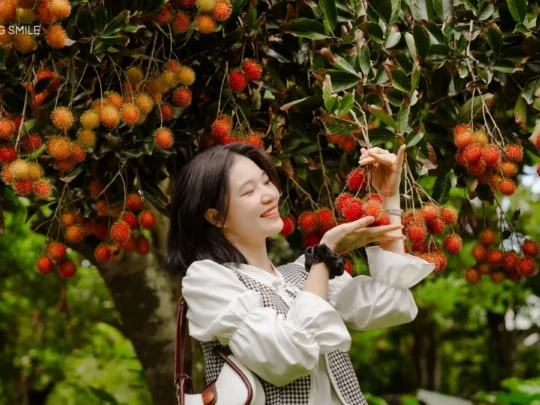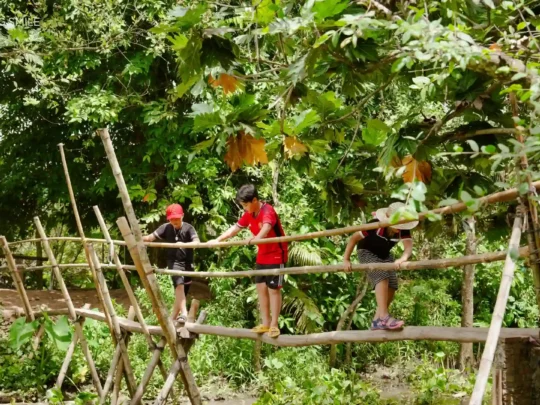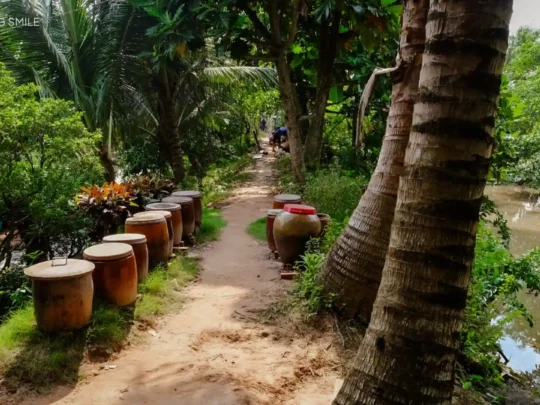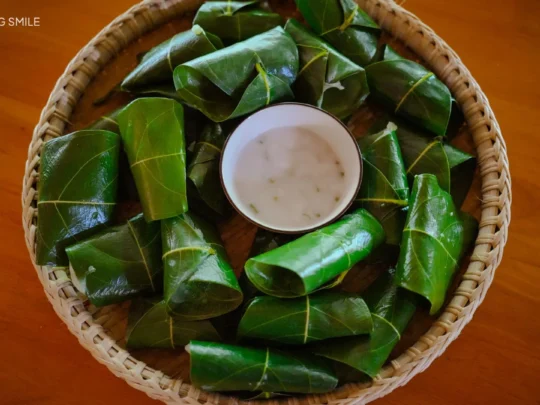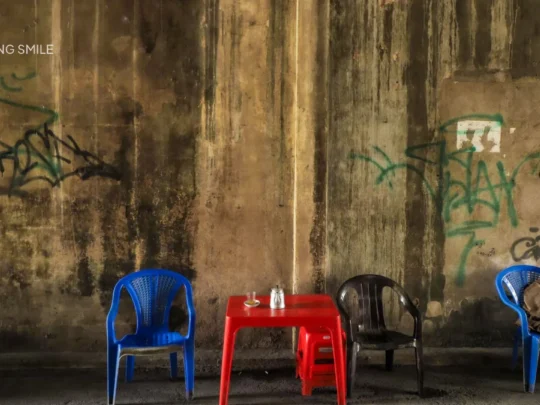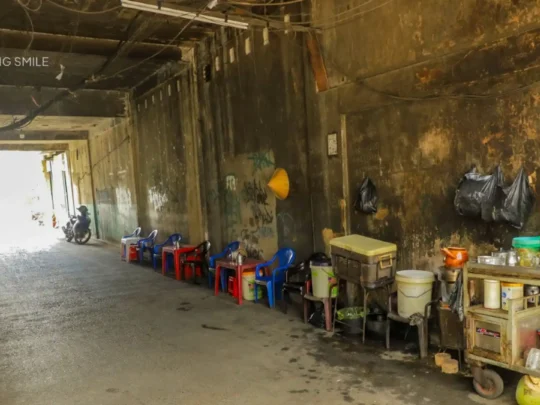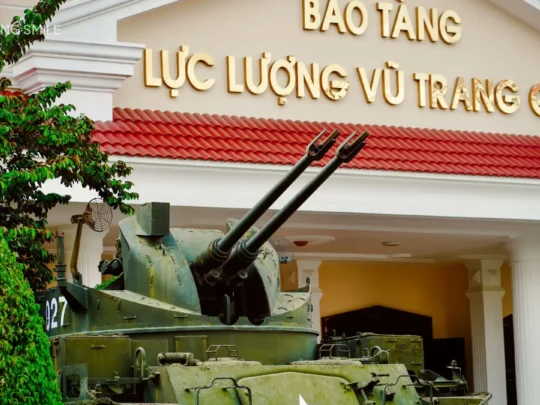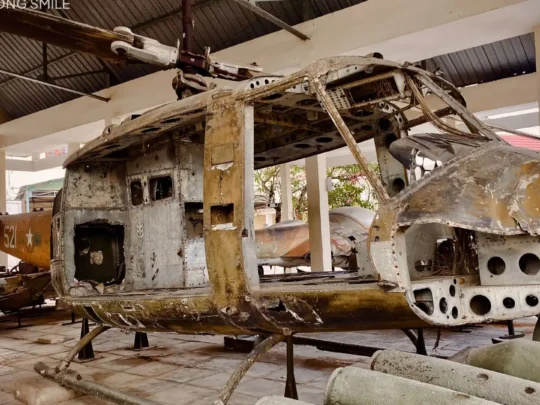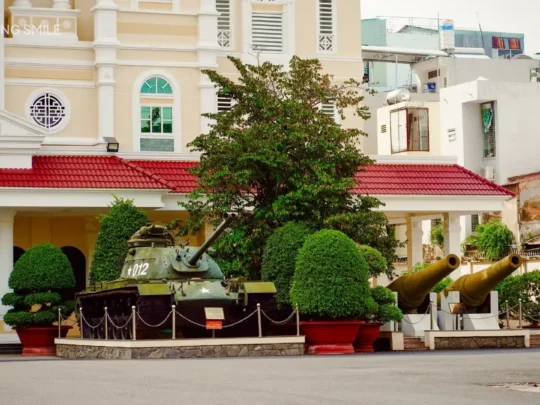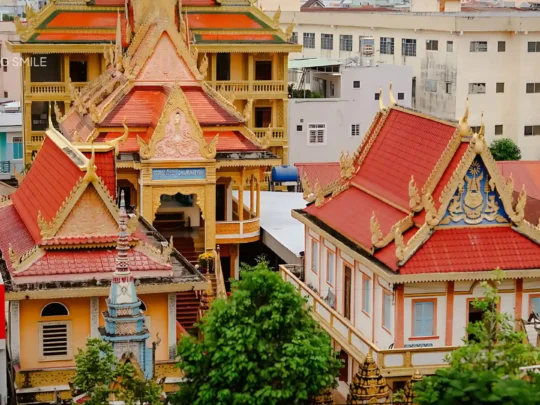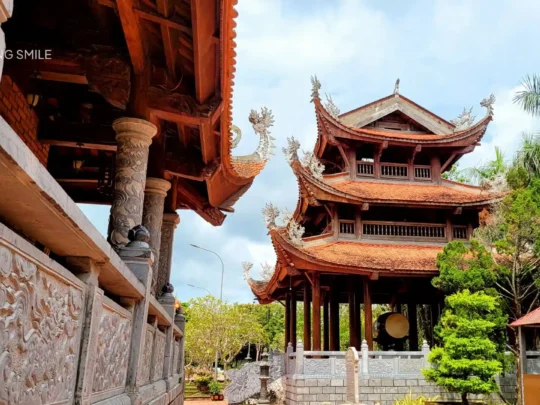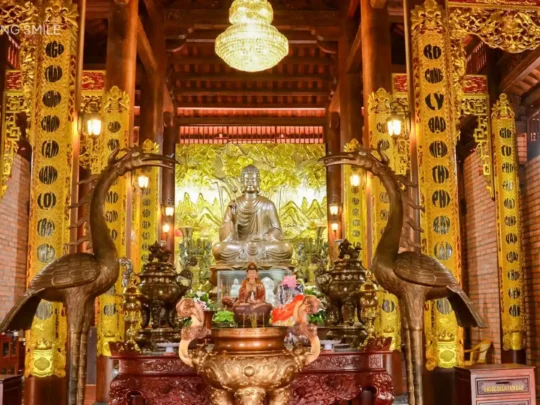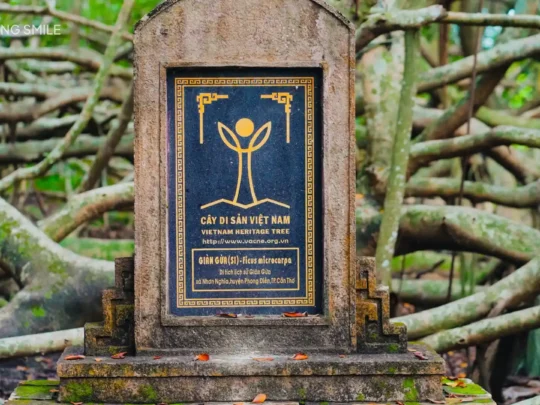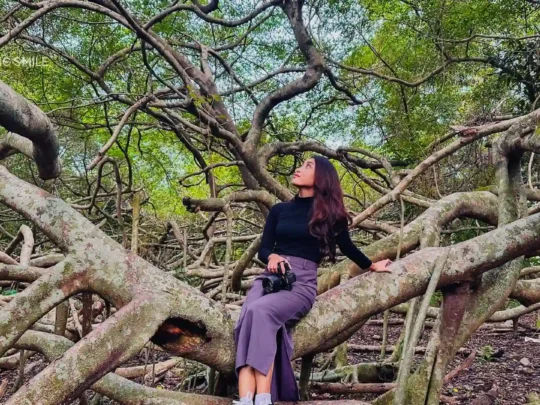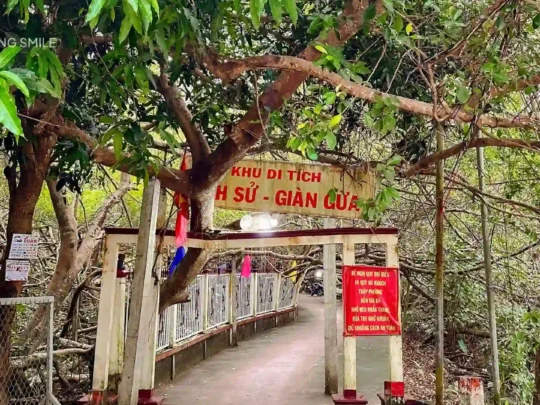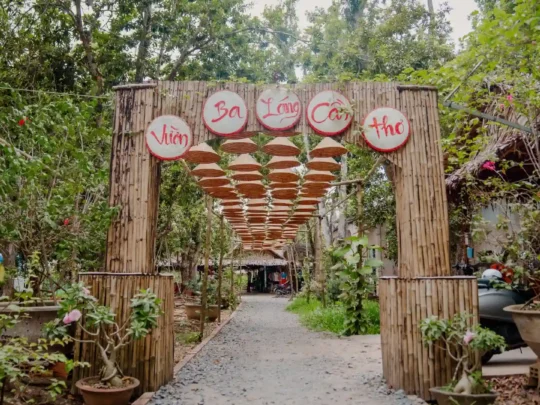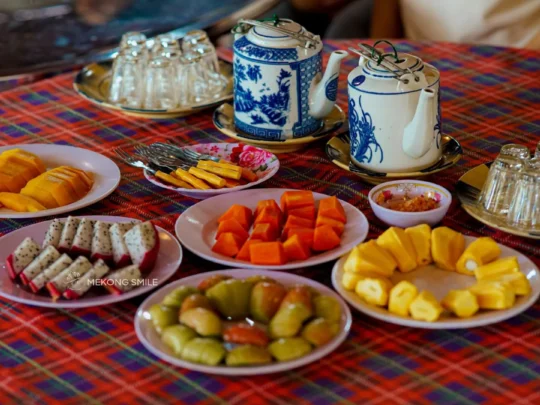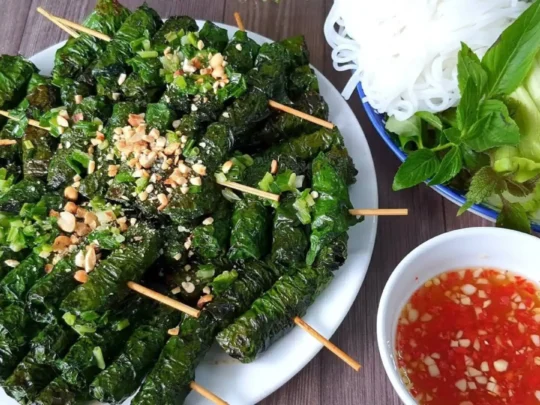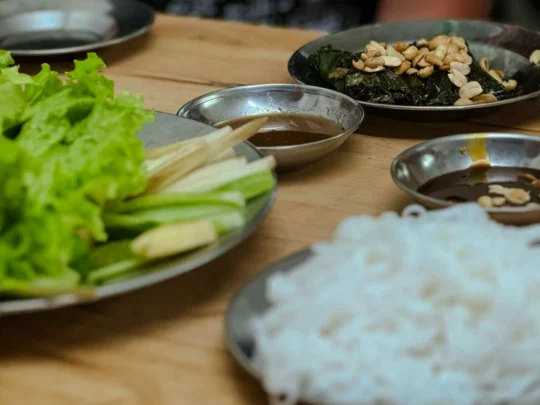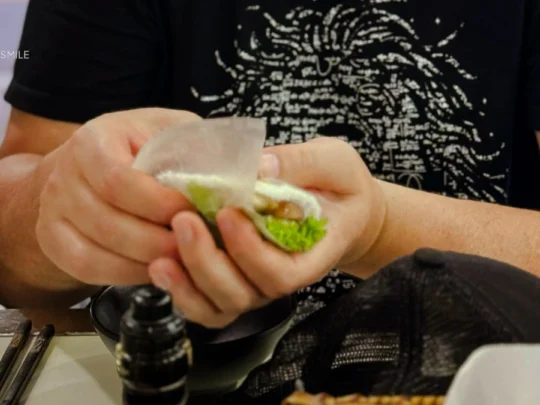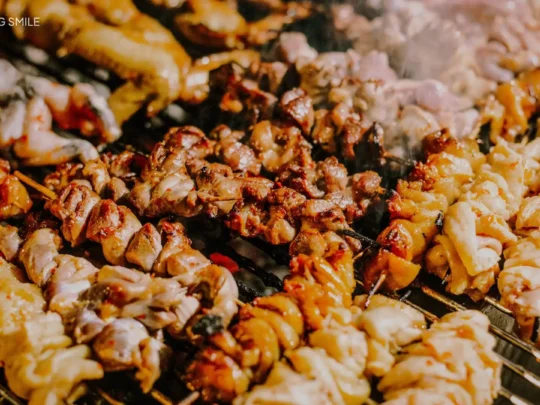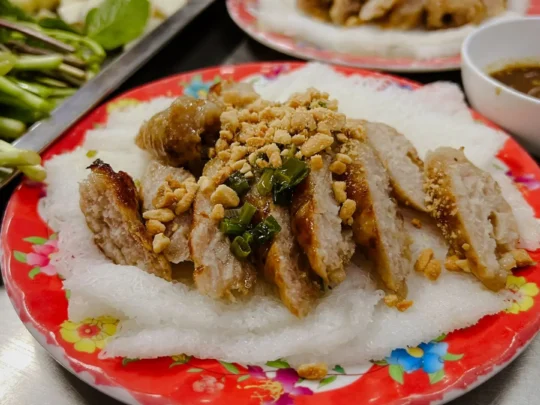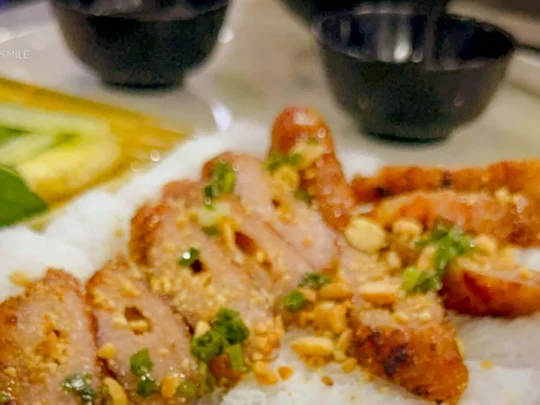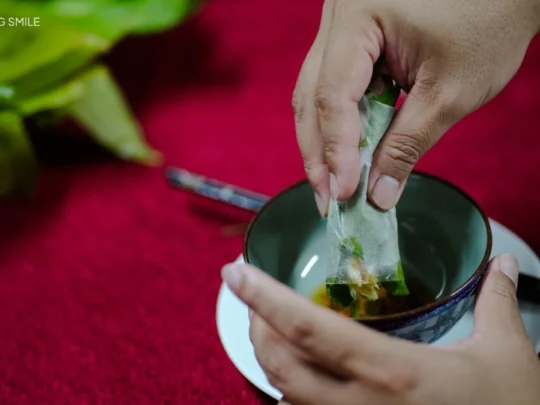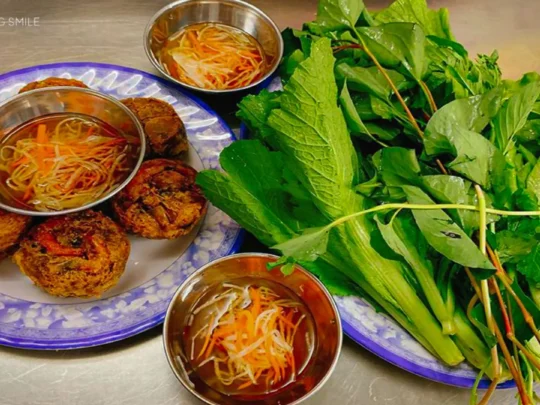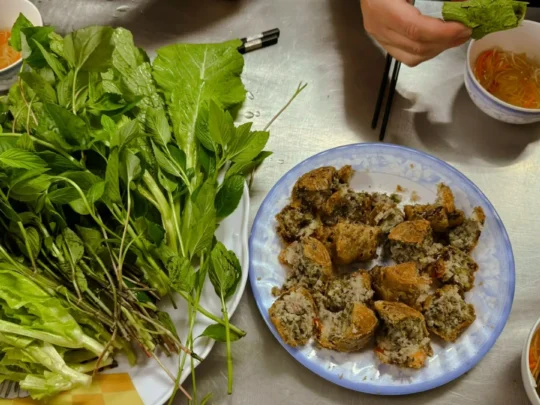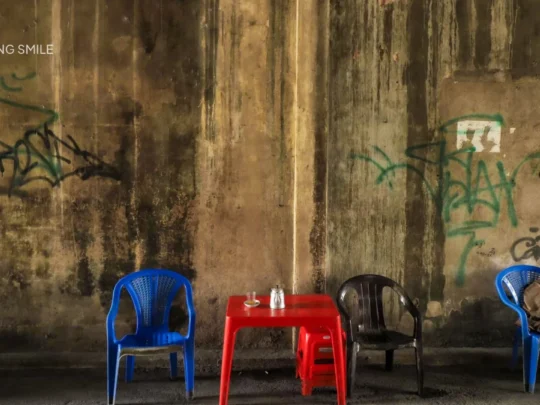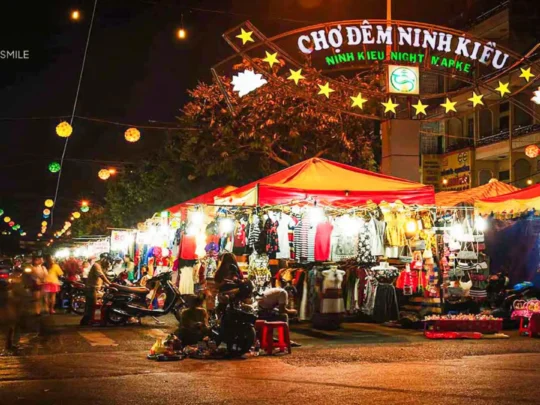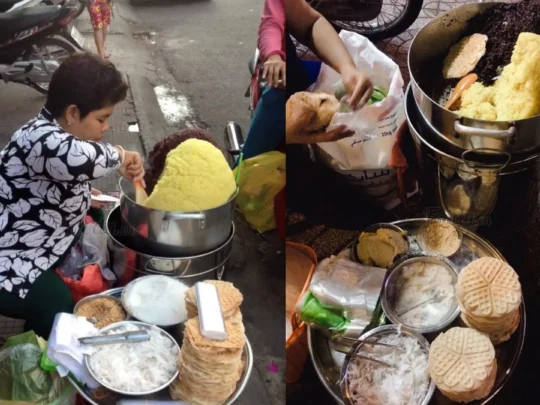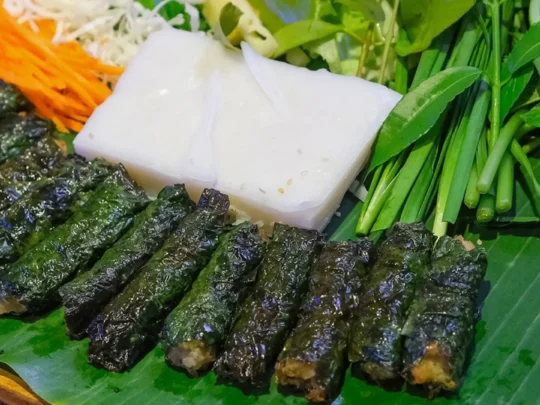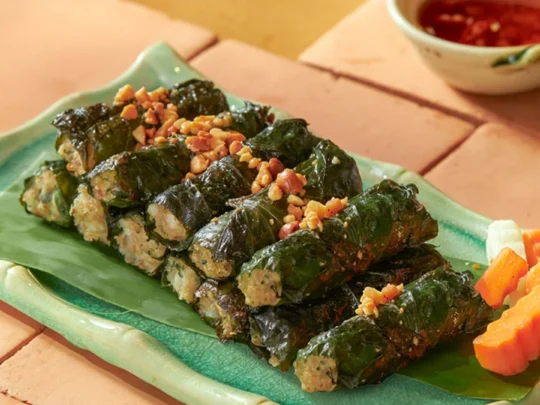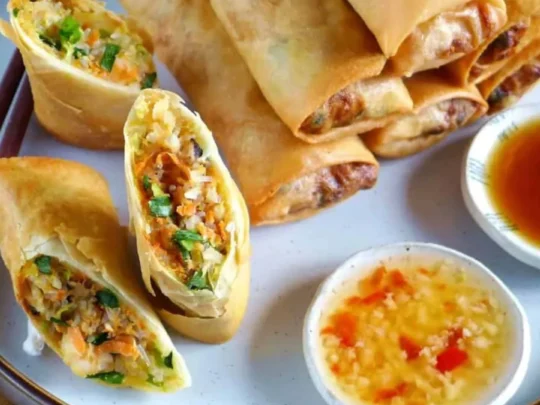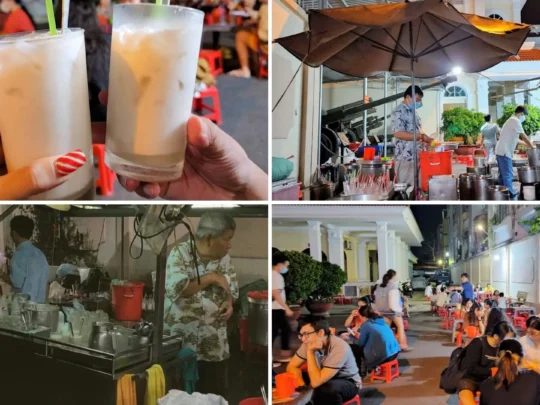Planning to visit Binh Thuy Temple but confused about what you’ll actually see? This comprehensive Binh Thuy Temple guide clears up the biggest misconception about a 180-year-old communal house (đình) dedicated to Vietnamese folk deities and village guardians.
You’ll discover why this distinction matters, what makes its wooden construction technique so remarkable, and which deities farmers have worshiped here since 1844. We provide exact practical details you need: the correct address, precise opening hours, and accurate transportation costs.
Beyond logistics, this guide helps you understand the cultural significance of Thành Hoàng worship, explains festival timing, and shows how to combine your visit with nearby attractions for an authentic half-day journey through Southern Vietnamese heritage.
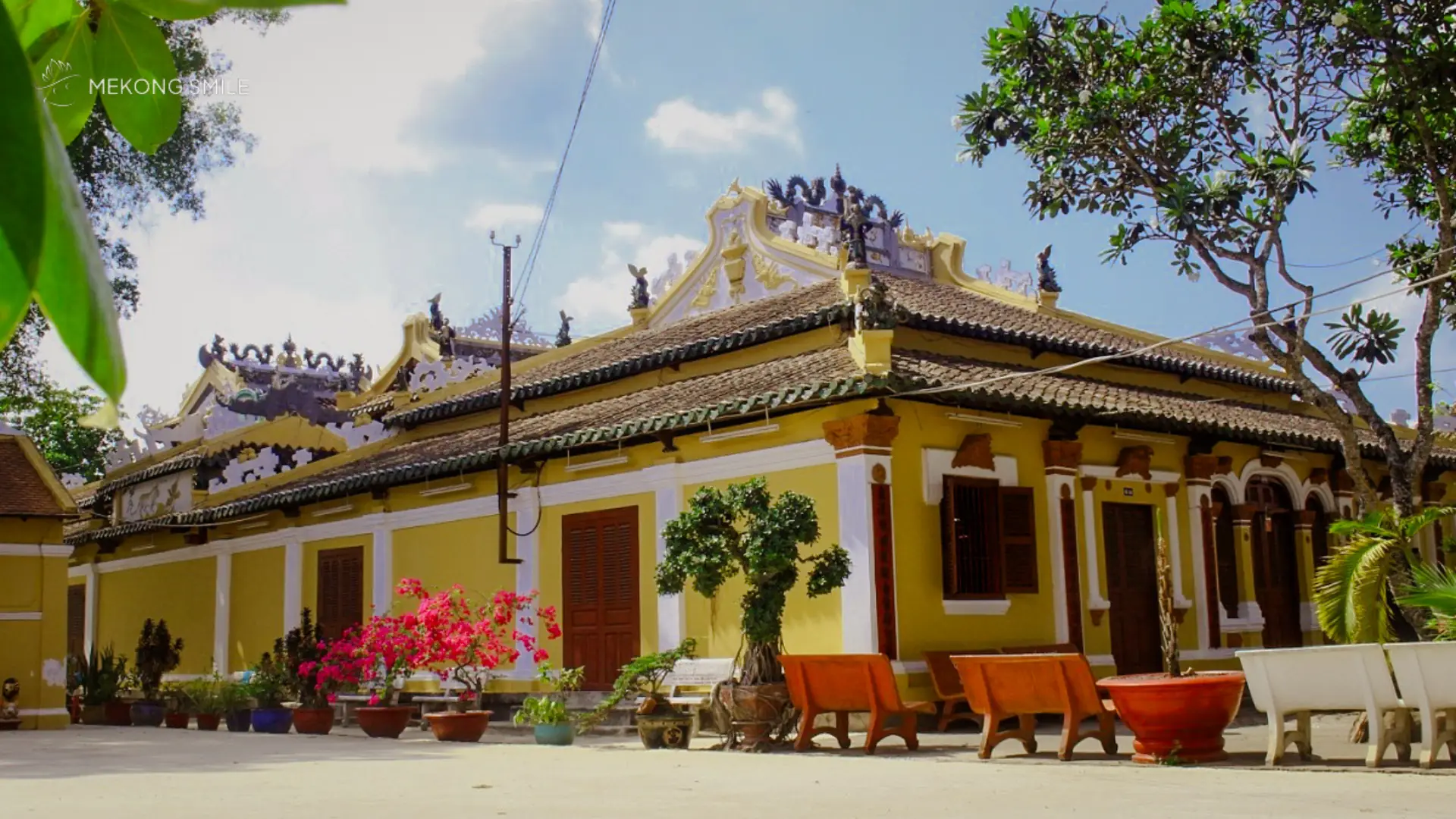
An Overview of Binh Thuy Temple (Đình Bình Thủy)
Official Name: Đình Bình Thủy (Binh Thuy Communal House) or Long Tuyền Cổ Miếu (Long Tuyen Ancient Shrine)
Important Note: Despite being commonly called a “temple,” this is actually a communal house (đình) dedicated to Vietnamese folk religion and village guardian deities – NOT a Buddhist temple (chùa). This distinction is crucial for understanding its cultural and spiritual significance.
A glance at Binh Thuy Temple in Can Tho
- Built: 1844 (originally simple bamboo and thatch structure)
- Royal Recognition: 1852 – King Tu Duc granted the title “Bổn Cảnh Thành Hoàng” (Village Guardian Deity)
- Last Major Restoration: 1909 (current structure)
- Location: 46/11A Le Hong Phong Street, Binh Thuy Ward, Binh Thuy District, Can Tho City (Approximately 5 kilometers from City Center)
- Opening Hours: 7:30 AM – 10:30 AM & 1:30 PM – 5:30 PM daily
- Entrance Fee: Free (donations appreciated)
- Parking Fee: 5,000 VND per vehicle
- Time Needed: 30-60 minutes
- Best Time to Visit: Early morning (7:30-9:00 AM) or during festivals (April & December lunar calendar)
The Rich History behind Binh Thuy Temple
Origins and Foundation (1844)
Binh Thuy Temple was first established in 1844 in Binh Hung village, Dinh Thoi district, during a period when the Mekong Delta was being actively settled and cultivated. The original structure was a simple cottage made of bamboo and thatch (tranh tre), built by early settlers who needed a spiritual center for their growing agricultural community.
Historical Significance:
- 1844: Original construction as a simple bamboo and thatch cottage
- 1852: King Tu Duc (5th year of his reign) granted the prestigious title “Bổn Cảnh Thành Hoàng” (Guardian Deity of the Founding Land), officially recognizing the communal house’s spiritual importance
- 1909: Major reconstruction and expansion to the current elaborate wooden structure
- Survived through history: The communal house endured French colonialism, wars, and social changes while maintaining its role as a community spiritual center
- Present day: Remains an active place of worship and cultural activities, preserved as a symbol of Southern Vietnam’s heritage
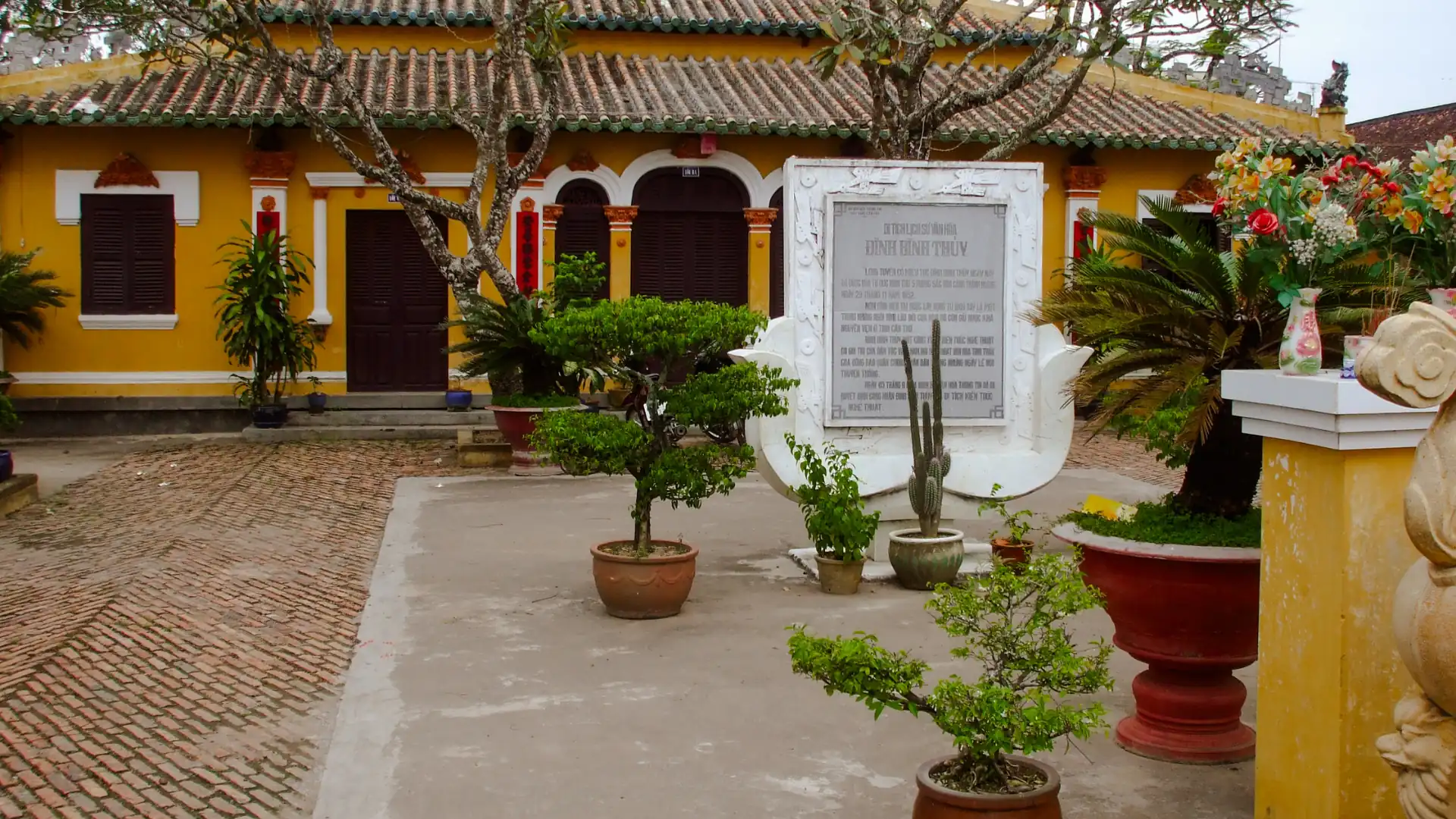
The Communal House (Đình) Tradition
Unlike Buddhist temples (chùa) or Chinese temples (miếu), Vietnamese communal houses (đình) serve a unique cultural-religious function. They are dedicated to:
- Village Guardian Deities (Thành Hoàng): Spiritual protectors of the community
- Agricultural Deities: Gods who ensure bountiful harvests and favorable weather
- Historical Heroes: Respected figures who contributed to the region’s development
- Community Gathering: Venues for village meetings, festivals, and social events
Binh Thuy Communal House exemplifies this tradition, worshiping deities and heroes essential to the agricultural life of the Mekong Delta.
Spiritual Significance: Deities Worshiped at Binh Thuy
Main Deities
Thành Hoàng Bổn Cảnh (Guardian Deity of the Founding Land)
- The primary deity, officially recognized by King Tu Duc in 1852
- Protects the village, ensures community prosperity and harmony
- Receives the most elaborate offerings during festivals
Thần Nông (Agricultural/Farm Deity)
- God of agriculture and farming
- Worshiped for bountiful harvests and successful crops
- Critical importance in this rice-growing region
Thần Rừng (Forest Deity)
- Guardian of forests and natural resources
- Reflects the importance of forest products to early settlers
Thần Khai Kênh Dẫn Nước (Water Irrigation Deity)
- “The deity who helps open canals and lead water”
- Essential in the Mekong Delta where water management determines agricultural success
- Honored by farmers for ensuring proper irrigation
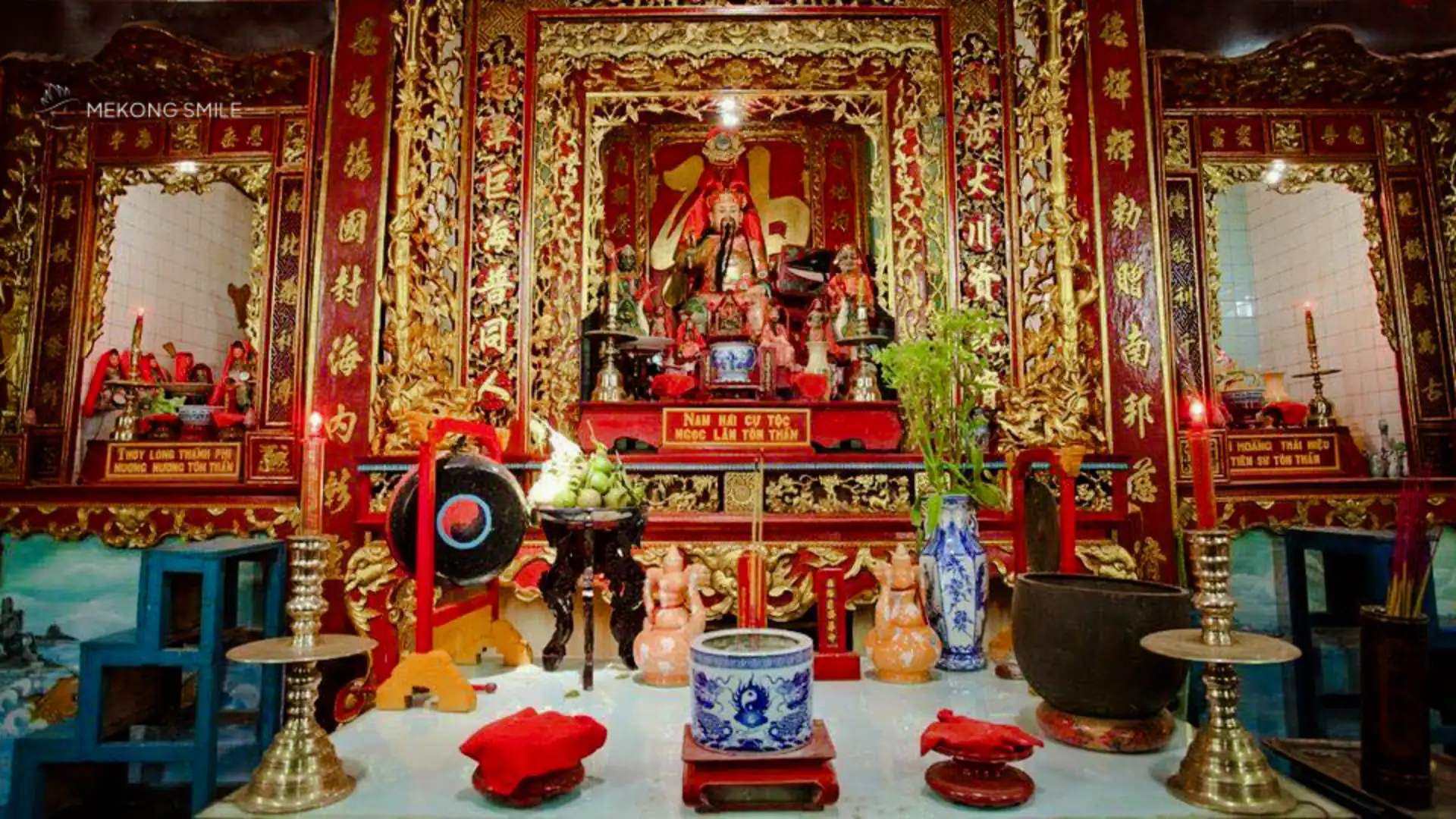
Historical Heroes Worshiped
The communal house also honors famous historical personalities who contributed to Vietnamese culture, politics, military, and economics: Bùi Hữu Nghĩa, Đinh Công Tráng, Nguyễn Trung Trực,…
This practice of worshiping both deities and historical heroes demonstrates the fusion of folk religion, ancestor veneration, and patriotic sentiment characteristic of Vietnamese spiritual life.
What to See and Experience
Main Ceremonial Hall (Chính Điện)
Highlights:
- Central altar area dedicated to Thành Hoàng and primary deities
- Elaborate wooden altars with multiple tiers displaying offerings
- Ornate carvings covering pillars, beams, and ceiling structures
- Incense smoke atmosphere creates a sacred, contemplative environment
- Traditional offerings: Fresh flowers, fruits, incense, ritual objects
- Ceremonial items: Ancient bronze vessels, wooden tablets, ceremonial flags
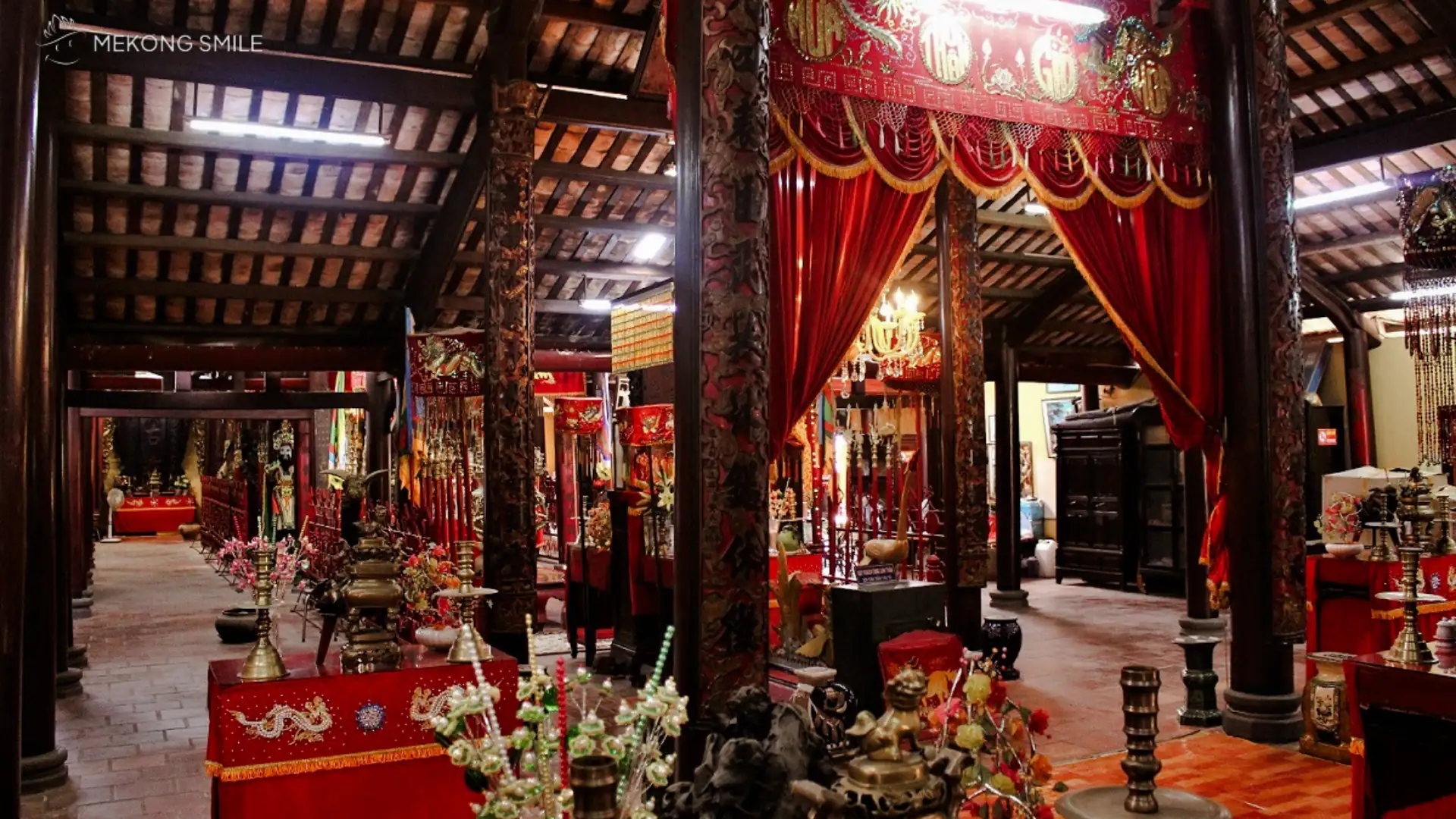
Front Hall (Tiền Đường)
Features:
- Secondary altar spaces for additional deities
- Reception area for festival ceremonies
- Display of traditional ritual implements
- Historical photographs and information panels
Courtyard and Exterior
Notable Elements:
- Chinese brick courtyard: Historic paving material imported during construction
- Rock gardens: Traditional landscaping with carefully arranged stones
- Potted ornamental plants: Bonsai and traditional Vietnamese garden plants
- Two small joss houses:
- One worshiping Thần Nông (Farm Deity)
- One worshiping Thần Cọp (Tiger Deity) – for protection
- Additional shrines near the gate:
- Thần Rừng (Forest Deity) worship space
- Thần Khai Kênh Dẫn Nước worship area
Architectural Details to Notice
Exceptional Craftsmanship:
- Examine the intricate wood joints showing no nails or metal fasteners
- Notice the red lacquer finish preserved for over a century
- Observe gold gilding on decorative elements
- Look for mother-of-pearl inlay on ornamental panels
- Study the carved scenes depicting Mekong Delta life – water activities, tropical fruits, and local flora
Festivals and Community Celebrations
Lễ Kỳ Yên (Ha Dien Festival – Crop Beginning Festival)
Time: 12th, 13th, 14th of April (lunar calendar) annually
Purpose: Pray to Thành Hoàng and other deities for favorable weather, healthy crops, and community prosperity at the beginning of the growing season.
Ceremonial Activities:
- Túc yết ceremony: Night vigil preparation
- Xây chầu ceremony: Building ceremonial offerings
- Đại bội ceremony: Grand worship ritual
- Mountain god offering: Special prayers to nature deities
- Rước Thành Hoàng: Procession carrying the deity statue for “sightseeing” around the village
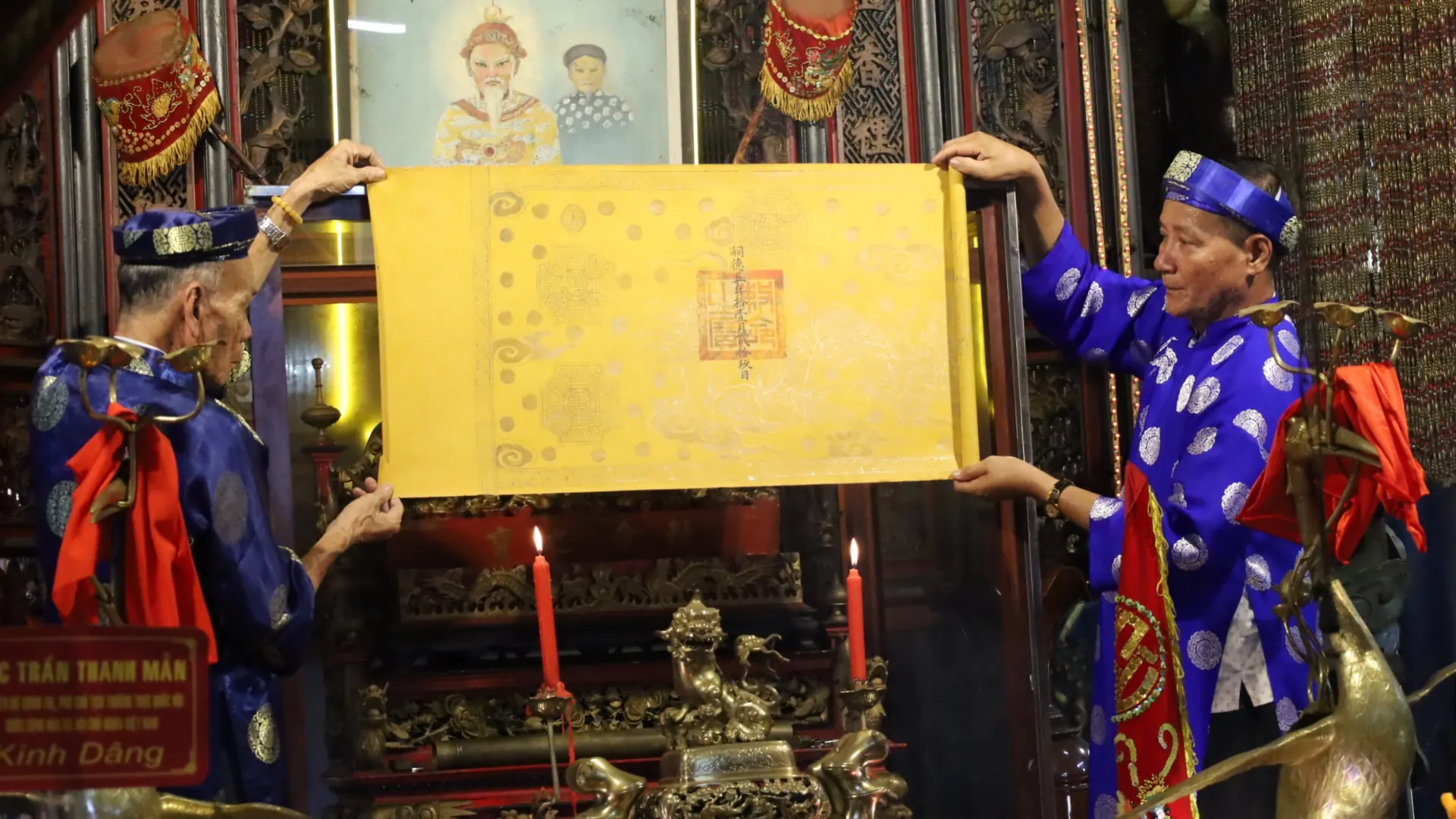
Lễ Lạp Miếu (Thuong Dien Festival – Crop Finishing Festival)
Time: 14th, 15th of December (lunar calendar) annually
Purpose: Express gratitude to Thành Hoàng and other deities after a successful harvest, give thanks for community blessings, and celebrate the year’s agricultural achievements.
Activities:
- Thanksgiving ceremonies and elaborate offerings
- Traditional performances (hát bội)
- Folk games and competitions
- Community relaxation and celebration after hard agricultural work
- Strengthening social bonds among villagers
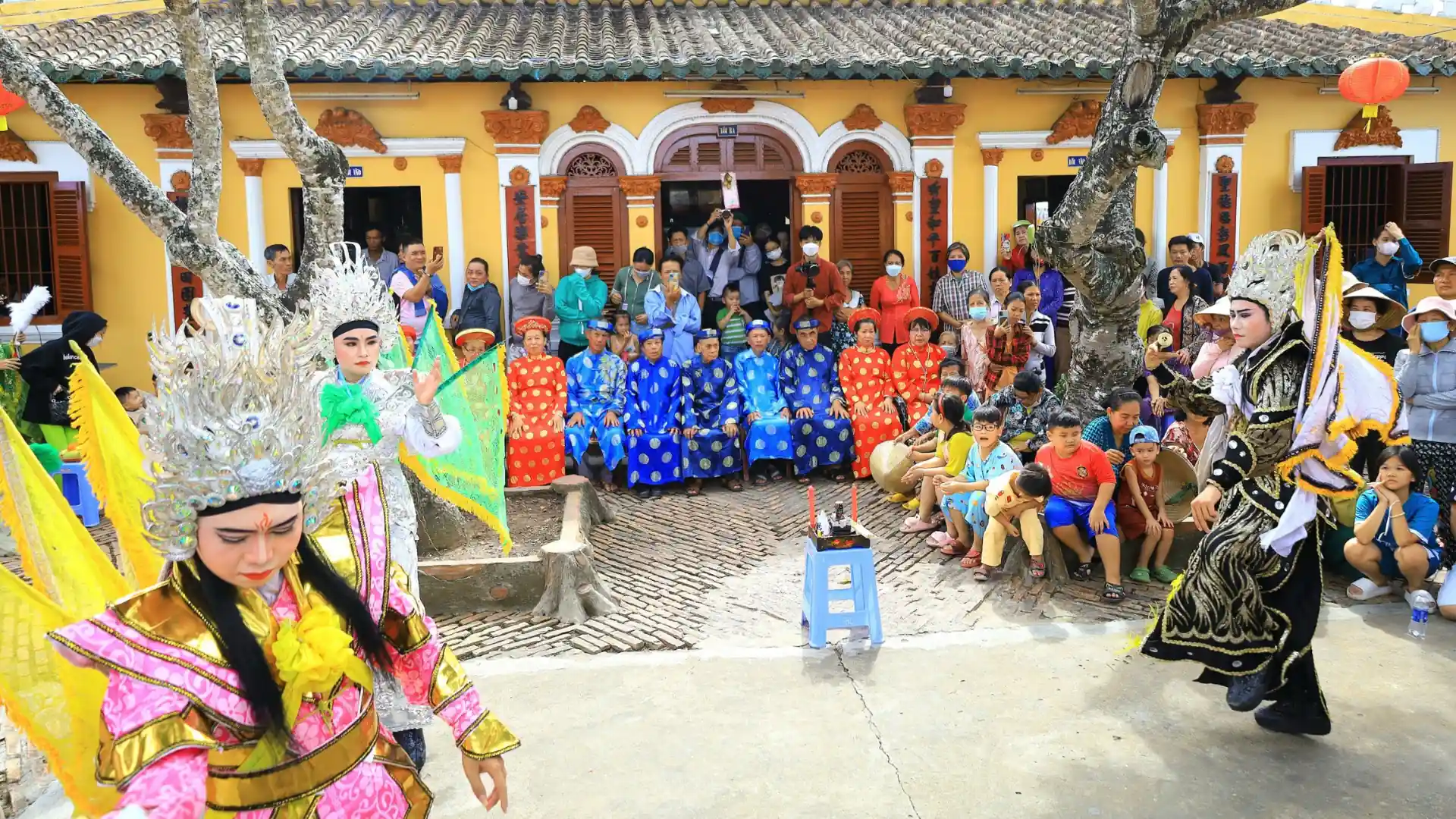
Practical Visitor Information
Location and Getting There
Exact Address: 46/11A Lê Hồng Phong Street, Binh Thuy Ward, Binh Thuy District, Can Tho City (Binh Thuy Temple on map)
Note: Many older sources list “Bui Huu Nghia Street” – this is outdated. The current address is Le Hong Phong Street.
Transportation Options:
By Taxi or Ride-Sharing (Grab):
- Most convenient for international visitors
- From Can Tho city center: approximately 60,000-100,000 VND ($2.50-4.00 USD)
- Travel time: 10-15 minutes, depending on traffic
- Simply show driver “46/11A Lê Hồng Phong” or say “Đình Bình Thủy”
By Motorbike:
- Rental available throughout Can Tho: 100,000-150,000 VND per day
- Follow Le Hong Phong Street toward Binh Thuy Ward
- Look for signs or use mobile map applications
- Parking available on-site: 5,000 VND
By Bicycle:
- Cycling distance from city center: approximately 30-40 minutes
- Scenic route along canal-side paths
- Good option for adventurous travelers in cooler morning hours
By Public Bus:
- Local buses serve routes to the Binh Thuy area
- Requires Vietnamese language skills and patience with schedules
- Less recommended for tourists with limited time

Opening Hours and Entry
Opening Hours:
- Morning session: 7:30 AM – 10:30 AM
- Afternoon session: 1:30 PM – 5:30 PM
- Open all days of the week
Note: These hours differ from typical Buddhist temples. The midday closure (10:30 AM – 1:30 PM) is traditional for communal houses during hot hours.
Entrance Fee: Free (no ticket required)
Parking Fee: 5,000 VND per vehicle (motorcycle or car)
Donations: While entry is free, visitors are welcome to make modest donations to support maintenance and community activities. Suggested amount: 20,000-50,000 VND ($1-2 USD), though any amount is appreciated.
What to Wear and Bring
Appropriate Dress Code:
For a communal house (đình) dedicated to folk deities and village guardians, visitors should dress respectfully:
- Clothing covering shoulders and knees (men and women)
- Modest, neat attire (avoid revealing or torn clothing)
- Easy-to-remove footwear (shoes removed before entering main halls)
- NO hats and sunglasses inside ceremonial areas
- NO beachwear, shorts, tank tops, or overly casual clothing
Recommended Items to Bring:
- Camera for photography (use respectfully)
- Bottled water (Can Tho’s tropical climate requires hydration)
- Small Vietnamese dong notes for donations and parking
- Sunscreen and hat (for sun protection in courtyard areas)
- Notebook for recording cultural observations
- Mobile phone with translation app (helpful for reading Vietnamese inscriptions)
Cultural Etiquette and Respectful Behavior
When Entering:
- Remove shoes before stepping onto raised platforms in ceremonial halls
- Observe quietly without loud conversations
- Turn your mobile phones to silent mode
- Move respectfully through sacred spaces
Photography:
- Temple exterior and architecture: photograph freely
- Interior altar areas: generally acceptable but respectful
- Avoid flash photography during any ceremonies or rituals
- Do not pose disrespectfully with sacred objects or altars
- If local worshippers are praying, maintain distance and discretion
Interacting with Offerings and Altars:
- Do not touch offerings, ritual objects, or altar items
- Do not lean on or sit on ceremonial furniture
- Avoid pointing feet toward altars or deity statues (considered disrespectful in Vietnamese culture)
- If you wish to make offerings, observe how locals do it first
During Festivals:
- Visitors are welcome to observe ceremonies
- Maintain a respectful distance from ritual activities
- Follow the local participants’ lead regarding when to stand, bow, or move
- If offered food during festival celebrations, acceptance is polite
Combining Your Visit: Nearby Attractions
Binh Thuy Communal House’s location in Binh Thuy district makes it ideal for combining with other cultural and natural attractions:
Binh Thuy Ancient House (200 meters / 5 minutes walk)
Highlights: Magnificent French colonial-era mansion built in 1870, featured in the film “The Lover” (L’Amant), exquisite period furnishings, beautiful gardens. Discover real insights about Binh Thuy Ancient House.
Con Son Islet (Cồn Sơn) – 10 minutes by boat
Distance: Short boat ride from Binh Thuy pier
Highlights: Community-based tourism village, traditional fruit gardens, local home-cooked meals, authentic Mekong Delta rural life, cycling through villages and gardens. Read about Con Son Islet for your trip.
Can Tho Rice Noodle Villages (2-3 km)
Highlights: Watch artisans making traditional bánh hỏi (fine rice vermicelli), observe bánh tráng (rice paper) production, century-old techniques still practiced, tasting opportunities, usually free or a small fee for tours. Read about Can Tho Rice Noodle Villages guide
Cai Rang Floating Market (6-7 km)
Highlights: Mekong Delta’s most famous floating market. Watch the real moment at Cai Rang Floating Market.
Bang Lang Stork Garden (12 km / 45 minutes) Highlights: Thousands of storks and waterbirds, beautiful natural setting, photography opportunities
Book your authentic Can Tho Tour with your Local Expert Tour Guide
Get your Own Advisor and Book Your Authentic Mekong Delta Tour
Get your free personalized Mekong itinerary - Leave your info and our local expert will respond within 5 minutes to help you design your most authentic trip:
Frequently Asked Questions (FAQs)
Is Binh Thuy Temple a Buddhist temple?
No, despite its common name, Binh Thuy is actually a communal house (đình) for Vietnamese folk religion, not a Buddhist temple. It worships village guardian deities, agricultural gods, and historical heroes – not Buddhist figures.
What are the opening hours of Binh Thuy Temple?
7:30-10:30 AM and 1:30-5:30 PM daily. Note the midday closure from 10:30 AM to 1:30 PM.
Is there an entrance fee for Binh Thuy Temple?
Entry is free, but donations (20,000-50,000 VND) are appreciated. Parking costs 5,000 VND per vehicle.
How do I get to Binh Thuy Temple from Can Tho city center?
Take a taxi/Grab for 60,000-100,000 VND (10-15 minutes) to 46/11A Le Hong Phong Street, Binh Thuy Ward. You can also rent a motorbike (100,000-150,000 VND/day).
How much time should I spend at Binh Thuy Temple?
Allow 30-60 minutes for the communal house. Combine with nearby Binh Thuy Ancient House (200m away) for a 1.5-2 hour cultural tour.
What should I wear at Binh Thuy Temple?
Dress modestly with shoulders and knees covered. Remove shoes before entering ceremonial halls. Avoid beachwear, shorts, or tank tops.

